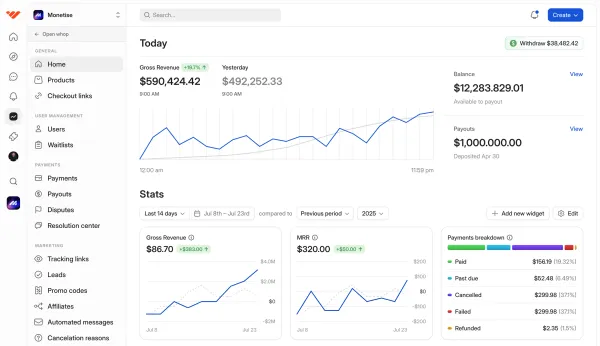Simplecast offers podcasters unlimited hosting, advanced analytics, and simple monetization options. But is it the right platform for you? Find out in this review.
Key takeaways
- Simplecast offers unlimited podcast hosting and storage starting at $15 per month.
- The platform provides IAB-certified analytics including listener demographics and download metrics.
- Recast feature creates shareable audio clips from longer podcasts for social media promotion.
- Users get automatic website creation tools with customizable themes and analytics integration.
- Private podcasting allows creators to limit episode visibility to selected audiences only.
Since podcasts can be listened to and downloaded from anywhere with an active internet connection, they have become a go-to source of information for the internet-savvy generation. This is also why the demand for podcasting as a career has increased.
If monetized properly, podcasting can be an excellent career choice for aspiring content creators. However, starting out as a podcaster might be a bit difficult and confusing, especially when it comes to selecting the right platform. After all, there are plenty of options to choose from today, which can overwhelm those who are not well-versed in this area.
Fortunately, one brand has established itself as a reliable and user-friendly podcasting platform. We are talking about Simplecast – a highly efficient podcast management solution.
If you are new to podcasting, you may not know what Simplecast is and how it works. But don’t worry - we have discussed and reviewed Simplecast in great detail in this guide.
Let’s get started!
Key takeaways
Simplecast’s features are exclusively tailored to podcasters’ requirements, and pricing starts at $15/month.
- Simplecast allows unlimited podcast hosting and management (despite the subscription plan)
- In-depth analytics
- Unlimited storage (regardless of the plan)
- Publish podcasts with one click to Spotify, Apple Podcasts, or the platforms your audience most engages with
- Embeddable and customizable media player that provides important audience insights
A brief overview of Simplecast
Simplecast is a platform designed specifically for podcasting.
It was founded in 2013 by its parent company, AdsWizz, a brand that specializes in audio content management. Using its expertise in this domain, Simplecast has positioned itself firmly as one of the leading podcasting management solutions today.
The platform has been refined and streamlined continuously over the past 10 years, taking into account user feedback and ever-changing industry standards.
Because of that, it provides some of the best tools for publishing, distributing, monetizing, and analyzing podcast content in the industry today.
Who can use Simplecast?
If you are a budding content creator with little experience in podcasting, then the aspect of user-friendliness might cross your mind. In fact, it is a major pain point for experienced podcasters as well.
No one wants to use a platform that offers its users the bare minimum of features.
Likewise, if it has a complex interface and is difficult to understand, its attractiveness to users reduces significantly.
That’s why it’s essential to choose the correct platform before beginning your podcasting journey. A platform like Simplecast, which has a proven track record of reliability, offers intuitive features and systems. The platform is easy to use, and you can quickly master it.
Simplecast is designed for creators - both established and beginners. Here’s a range of suitable users:
- Content creators: Bloggers, vloggers, or creators in general can share their audio content through multiple platforms using Simplecast’s distribution feature
- Independent podcaster: People interested in creating and managing their personal podcasts can use the intuitive feature and analytics of Simplecast to create their podcasts
- Business and organization: Companies can use Simplecast to produce and distribute their audio content either for training their employees, marketing, or various other purposes.
- Teams and collaborators: Simplecast allows multiple users to create podcasts collaboratively and has different permission access depending on the pricing plan.
If you are a fairly experienced podcaster, you may want access to advanced features like data analytics, comprehensive content and channel management, and other similar frameworks to streamline your podcast.
Thankfully, Simplecast has got you covered in this aspect as well, for it comes packed with high-end systems that can optimize your podcast performance.
Aside from the expertise levels, Simplecast is highly versatile in terms of scope. If you are an indie content creator with a niche audience, it has all the necessary tools to keep your podcast relevant and profitable in your domain.
On the other hand, if you want to expand your podcast and create a diverse network, you can do that as well. So, with the tools provided by Simplecast, you can easily scale your podcasting profile to maximize reach.
Important features of Simplecast
Let’s look into some of the key features and tools offered by Simplecast that you can use to create a seamless podcasting experience.
Recast
One of Simplecast's most popular and advertised features is its Recast functionality. It’s a unique podcast discovery and sharing tool that helps you create custom audio clips from your podcast library.
With it, you can edit a large podcast file into shorter and simpler clips using a handy audiogram. You can then share these customized clips on your social media profiles to drive engagement.
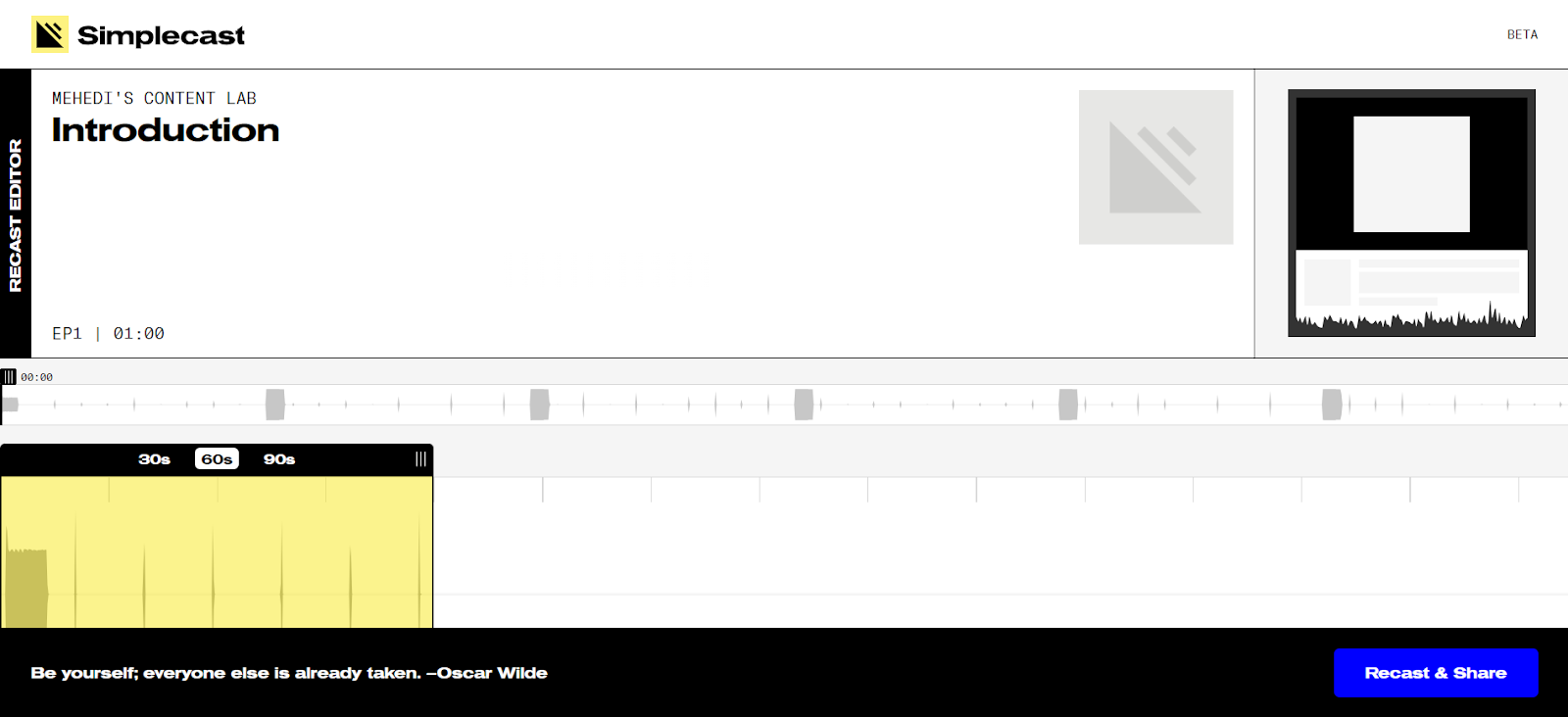
Recast makes it easy for your listeners to discover relevant clips from your channel. This can be incredibly useful for expanding your reach and getting more audience.
For example, if you upload an hour-long podcast to your social channels, most people won’t have the patience or time to listen to the whole thing, and some might not find the whole podcast relevant.
That’s why using Recast, you can create a much shorter highlight of your podcast, which can hook listeners quickly.
Podcasting statistics and advanced analytics
Simplecast provides a wide range of statistical and analytical tools, which is another reason it’s so highly regarded among podcasters today.
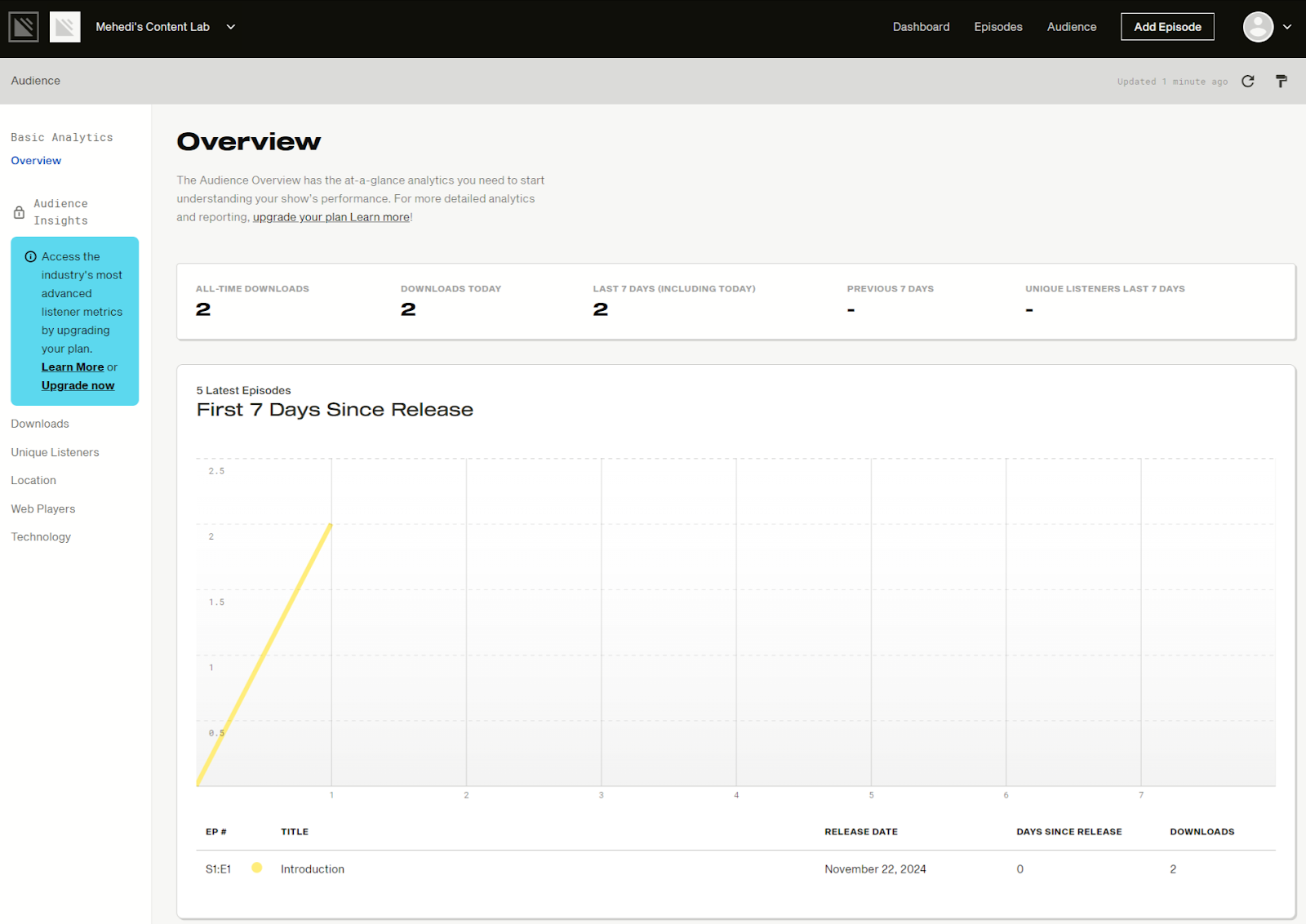
Since we just created a new podcast, we don’t really have any detailed analytics showing up yet. Also, to unlock the full analytics access, you’ll need to upgrade to a paid version.
But here’s what it’ll look like with a paid subscription and an active podcast with engagement.
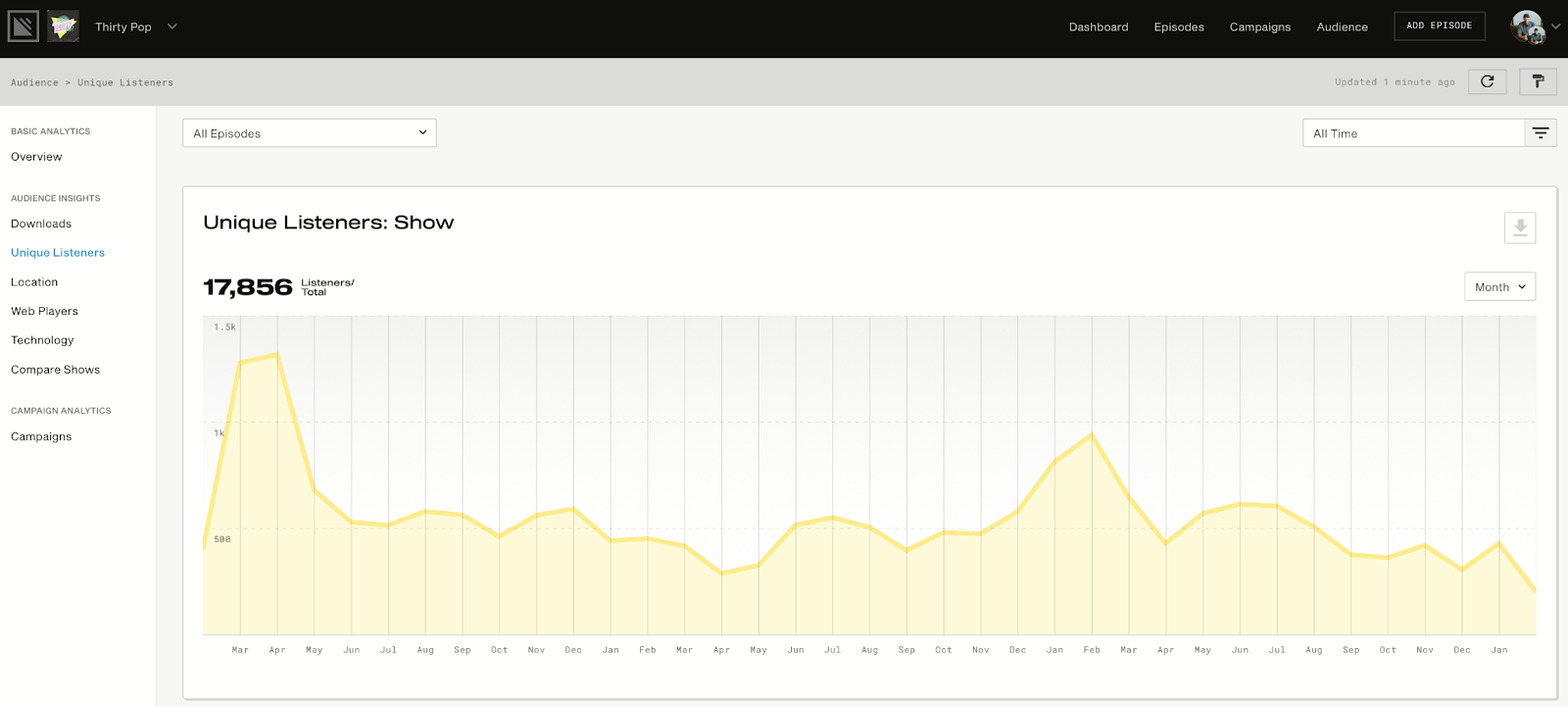
Data in the paid plans may include different metrics for a podcaster, such as unique listener count, downloads, location of your listeners, technologies used, and more.
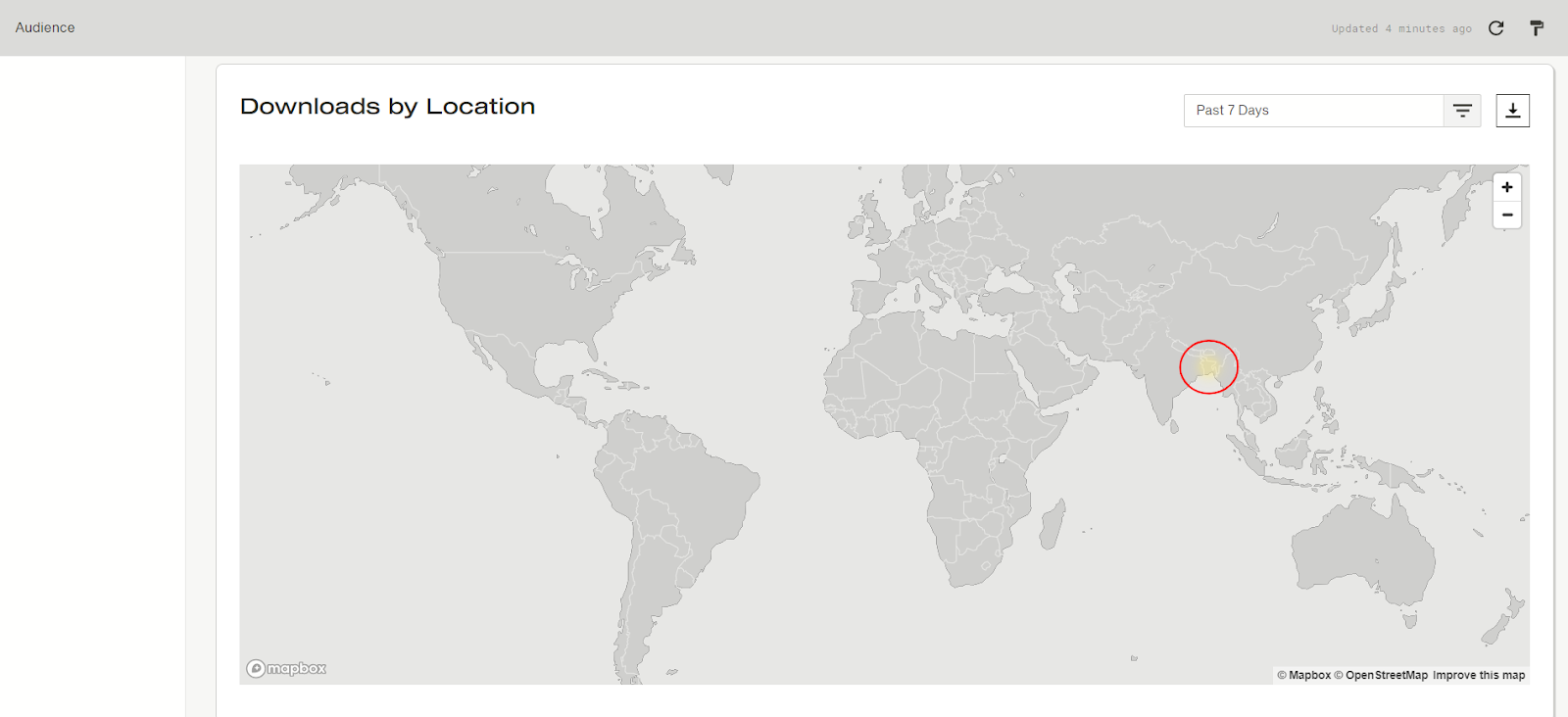

As you can understand, the above data can highlight your podcast's overall reach and reveal the demographic details of your audience.
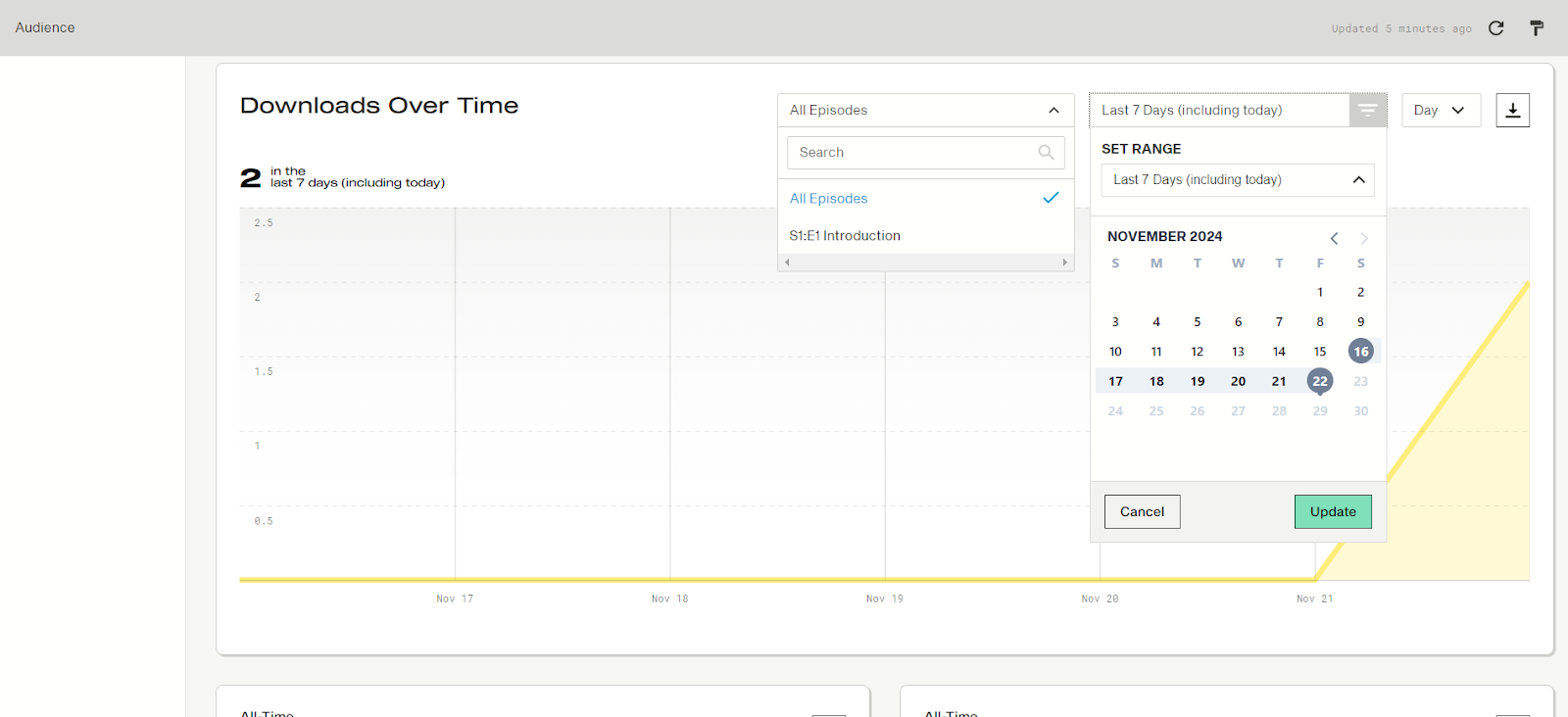
Of course, these are only the fundamental metrics that you can measure via the stats and analytics tools of Simplecast. The actual range of these tools is much more diverse.
For instance, you can refine the downloads metric based on several filters, such as all-time total download count, last 7-day downloads, download count today, and others.
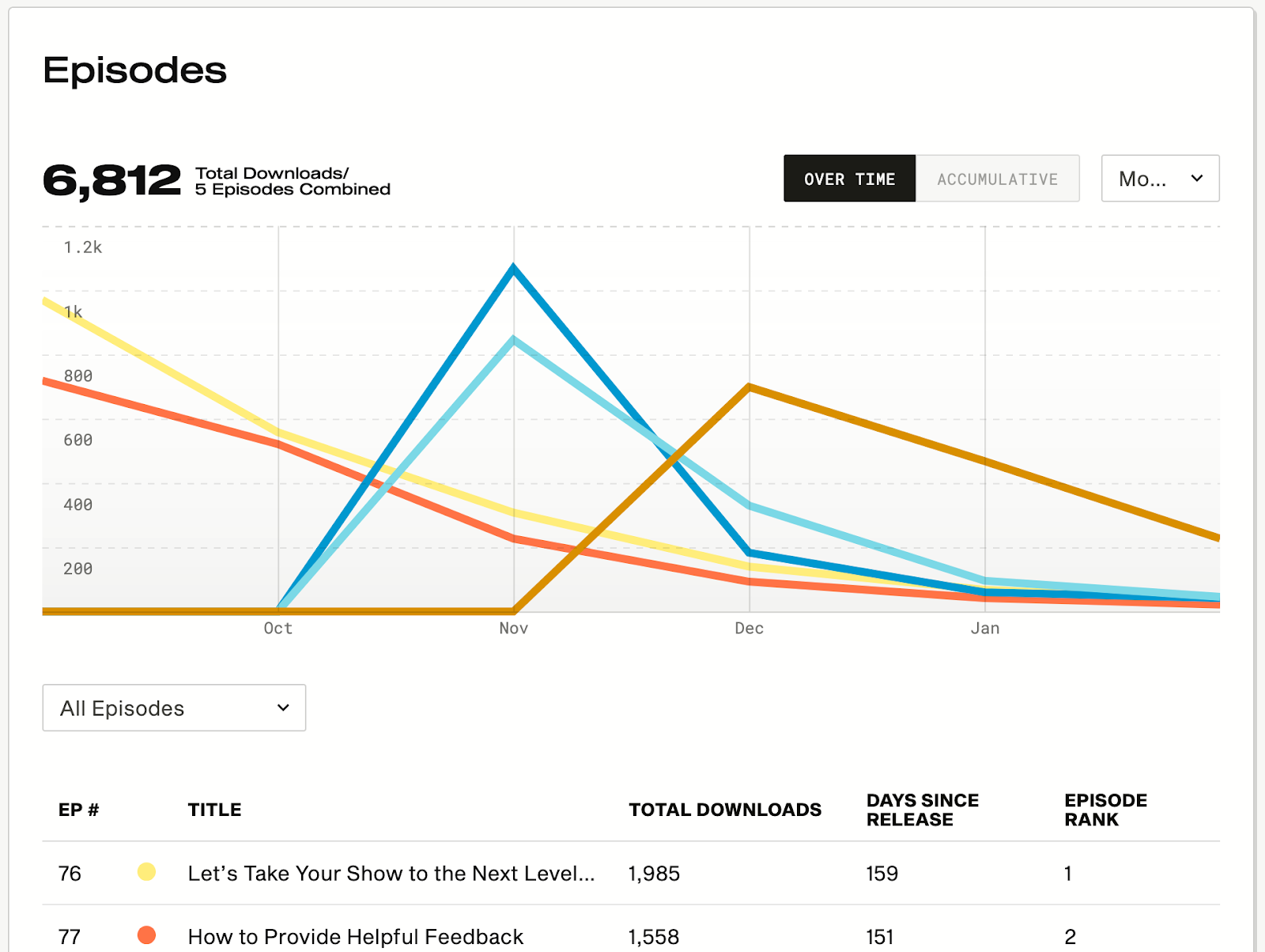
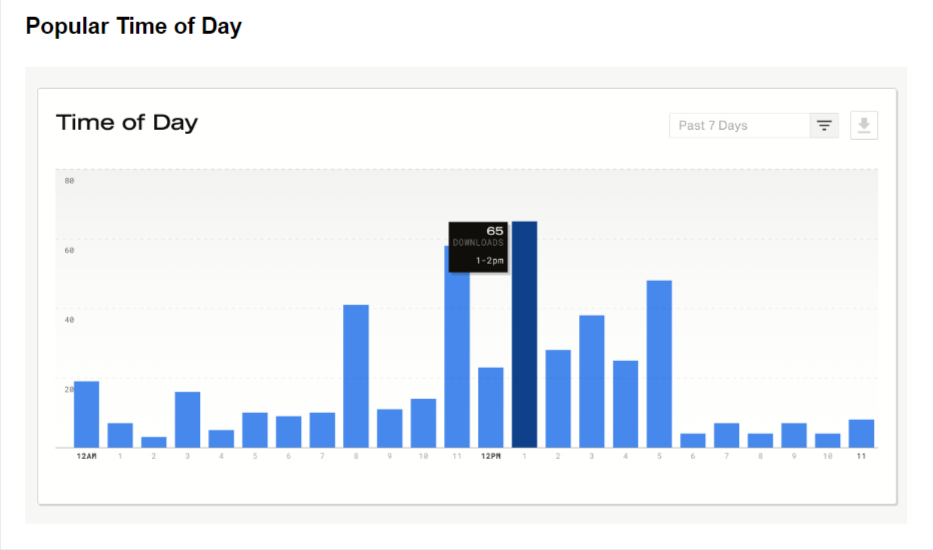
Likewise, there are filters that you can use for the other metrics to refine the statistics, such as popular time of day, top episodes, network providers, devices used, and so on.
With such comprehensive data, you can naturally perform a thorough analysis of your podcast’s performance, thereby allowing you to fine-tune your content according to the audience’s needs.
What’s more, all of these enterprise-grade tools are IAB-certified so that they meet all the relevant industry standards. Plus, they are quite affordable, which makes them easily accessible to all podcasters on the platform.
Websites for podcasting
As a beginner, you may be wondering why it is important to have a podcasting website of your own. But believe us - having a dedicated website can give your podcasting profile a significant boost.
It's the reason why most veteran podcasters have their own websites to host their podcasts and other related content.
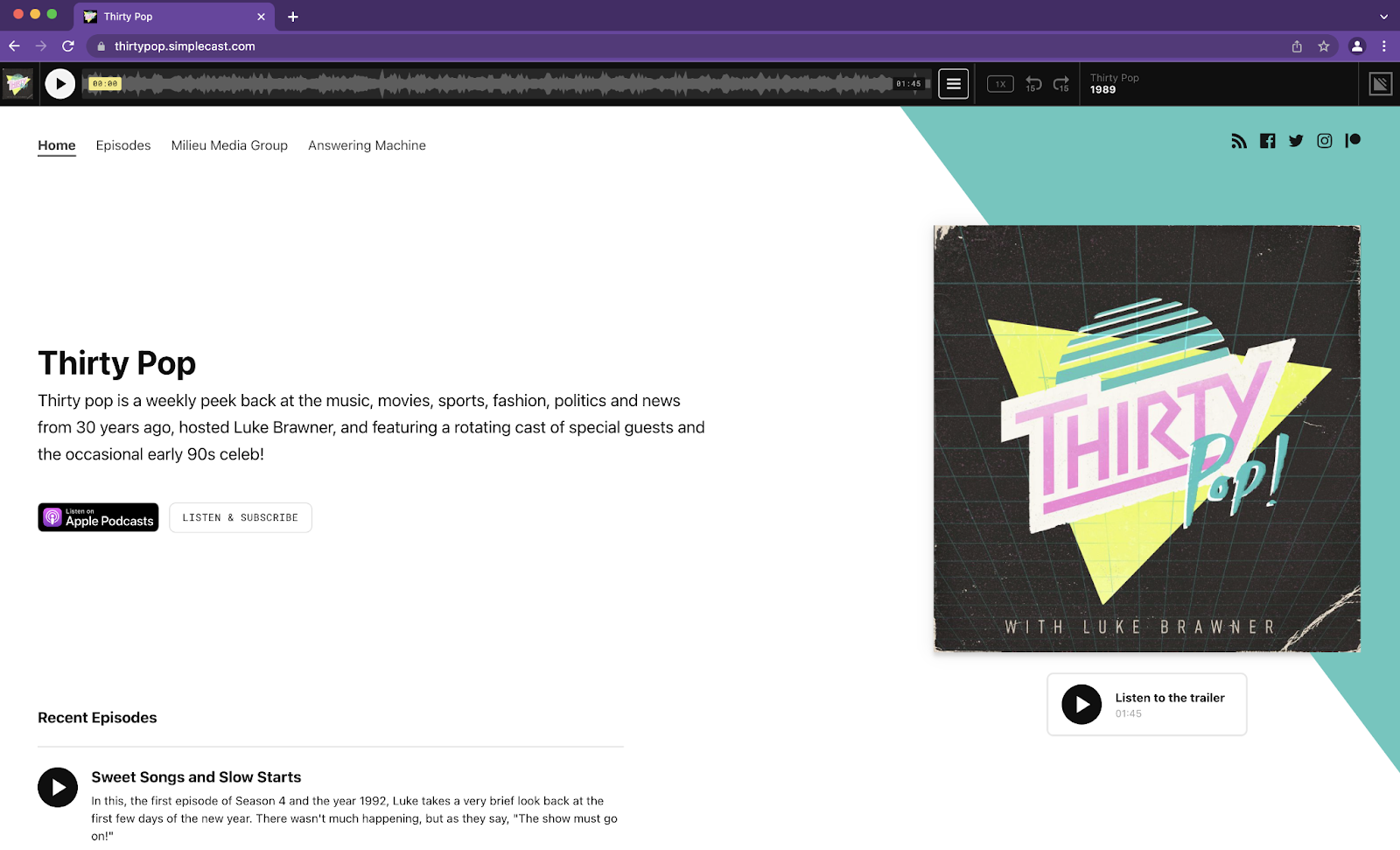
While it’s important to focus on the quality of your podcasts, the presentation also matters. That’s what a website does - it provides your listeners with an interesting online space they can access easily.
Besides, if you make your website engaging enough, it can even help you attract new audiences.
Luckily, Simplecast comes with a website creation and hosting tool that allows you to create an attractive website for your podcasts. At first, the idea of operating a dedicated website may seem daunting for many podcasters, but it’s not hard to do.
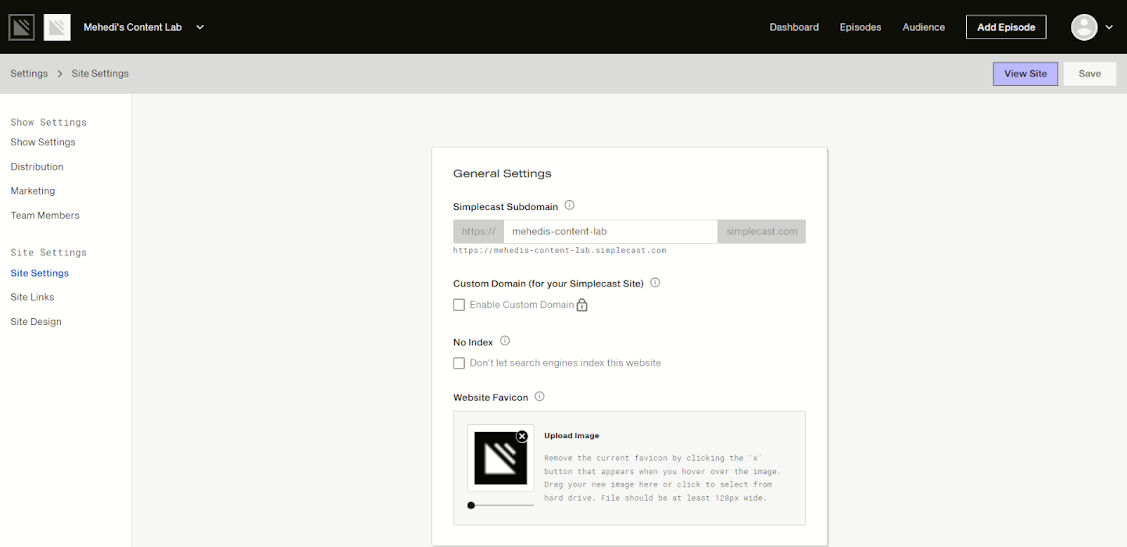
The interface is fairly simple and has basic requirements. It lets you display your show’s name, the description of your podcast, and the episodes. There isn’t an option to change the text on the Simplecast website designer; however, you can highlight your content as you make changes in the podcast settings.
The platform allows you to add links to external websites and social media accounts. You can also connect to Facebook Pixel and Google Analytics.
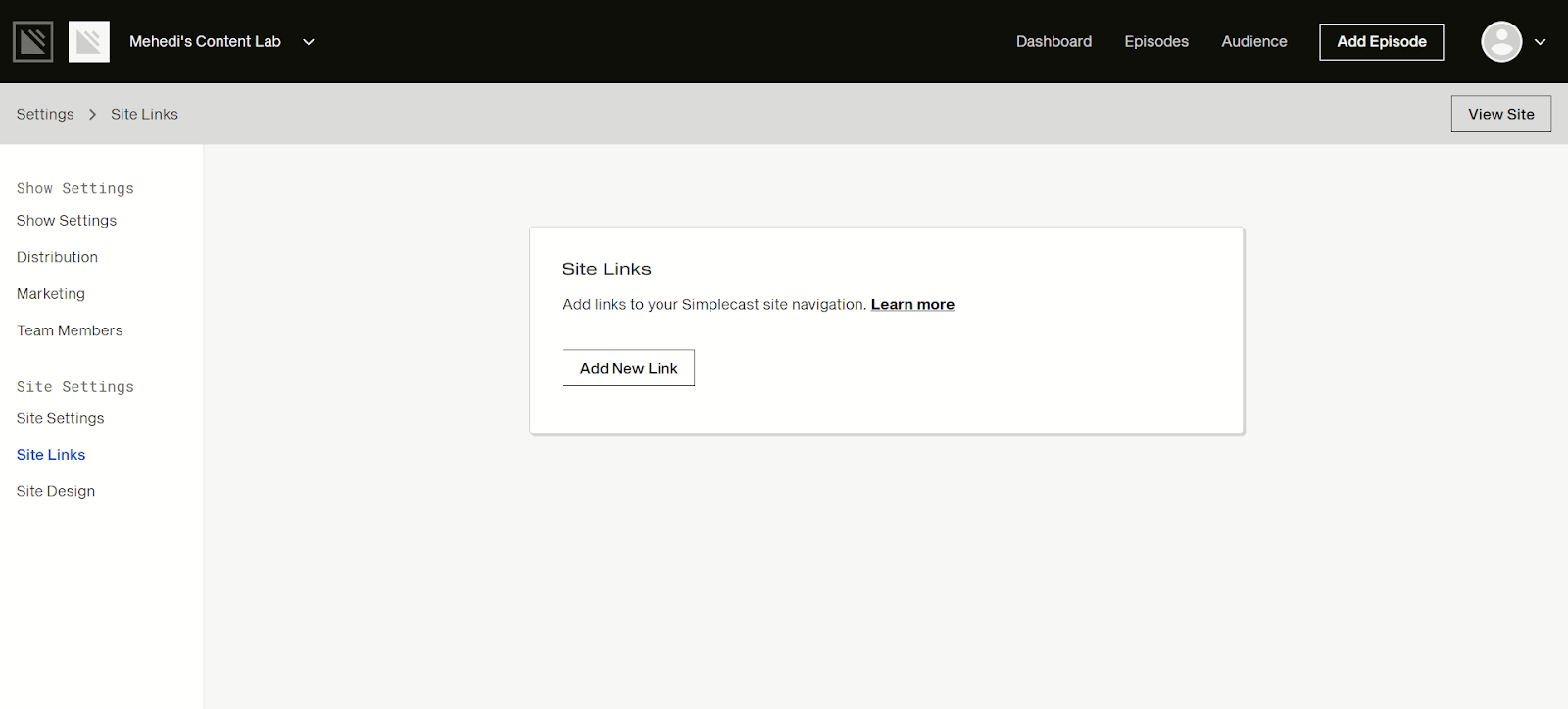
While you only have one default podcast theme and can’t change that to something else, it does provide the option to choose between dark and light colors. In terms of customization, you can add texture, which basically changes the color of the top right part.
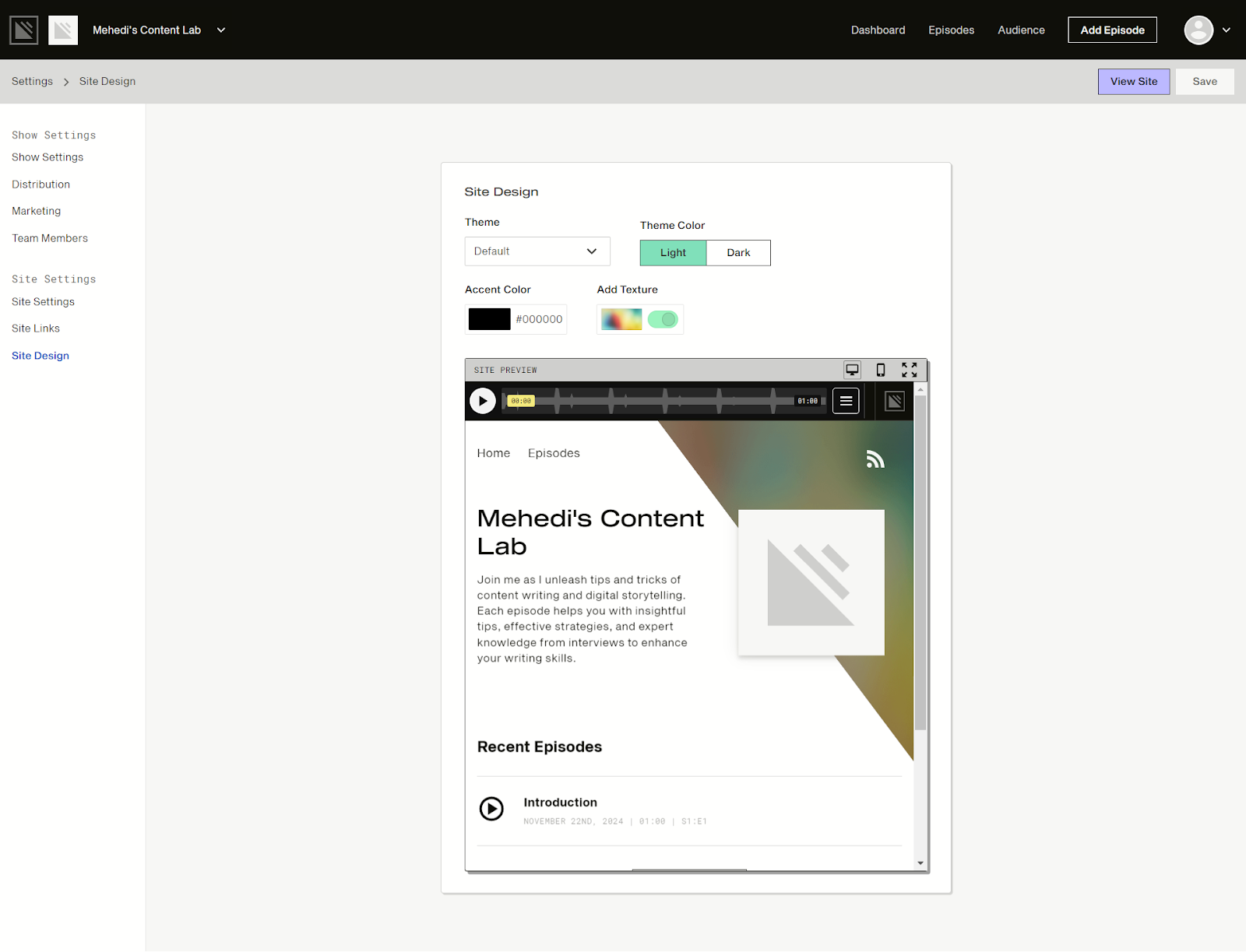
The website creation tools are simple and easy to understand, and they allow you to customize and optimize your website according to your liking.
The automatic update functionality ensures that the site gets updated automatically whenever you upload a new podcast episode or make any changes to your existing ones.
Web-based audio player for podcasts
In many cases, podcast listeners are required to download a specific app to listen to their favorite podcast. While this system has advantages, such as targeted content delivery and a convenient hosting ecosystem, it also has several disadvantages.
The biggest one is that the listeners cannot access the content without the app, which reduces the overall flexibility.
Simplecast understands that most listeners tend to discover new podcasts while browsing the web. Thus, web browser support is crucial for ensuring access to podcasting content for new and existing audiences.
That’s why this platform comes with a simple audio player that can run on regular web browsers without needing any external app installations.
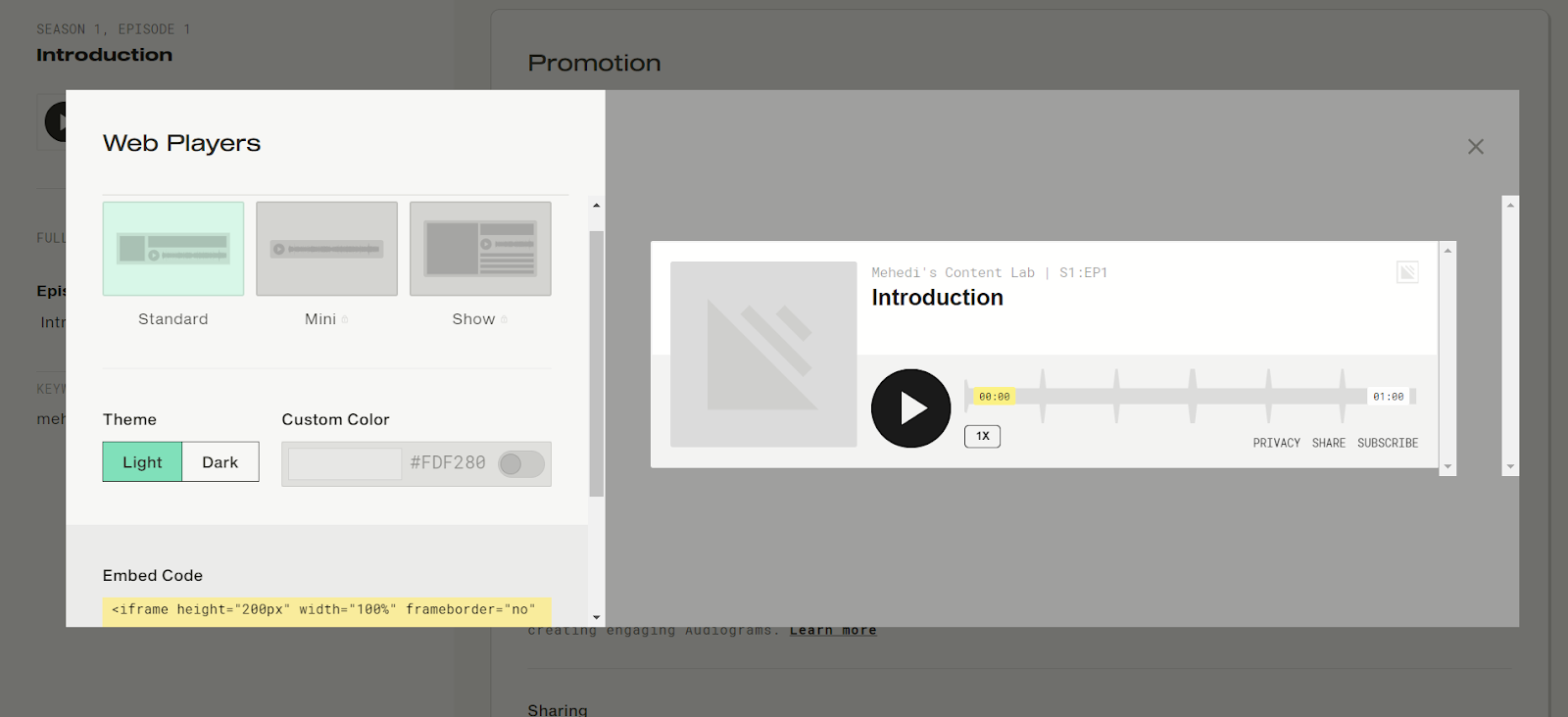
Of course, simplicity is not the only thing that makes Simplecast’s web player stand out. It has a beautiful and highly intuitive interface that gives the listener full control over what they are listening to. It records various data, such as share points, listening speeds, and drop-offs, all of which can provide valuable insights.
The web player is available in three sizes: Standard, Mini, and Show. However, you can only find Mini and Show in the upgraded plans. The platform doesn’t even allow color customization in the Basic subscription.
One privilege is that you can get a preview of all the players at once and go for the one that’s best for your podcast/episode. It also comes with a direct subscribe and share button for the listeners’ ease of use.
The player also uses intelligent algorithms to analyze the listener’s preferences and offer unique podcast suggestions. Naturally, this provides a great opportunity for up-and-coming podcasters, who can be discovered by new audiences easily.
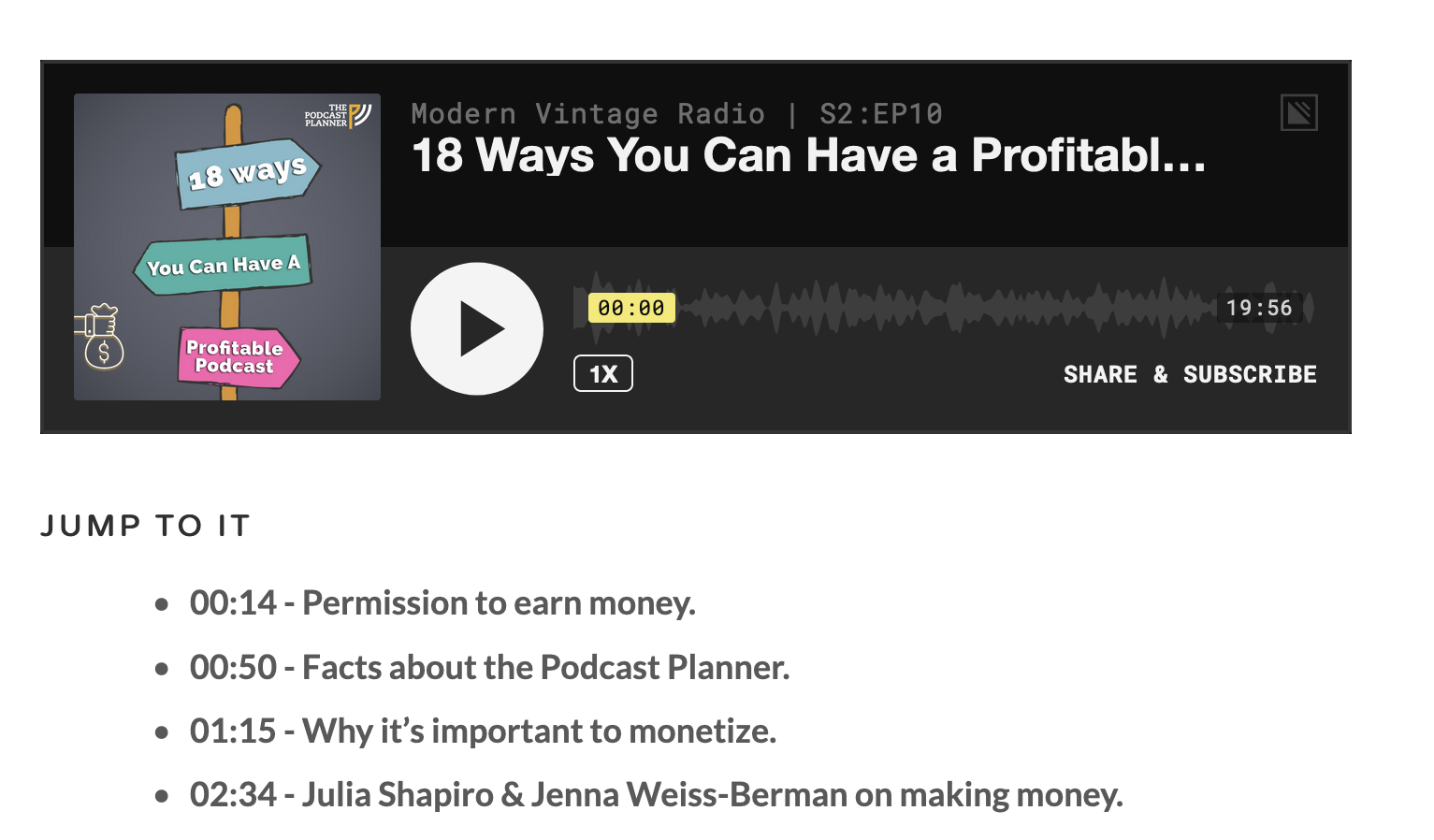
Furthermore, the Simplecast web player is Embed-ready, which means that it is easy to embed on other web pages and third-party sites.
For example, if you have social media pages on Facebook and Twitter/X, you can embed the player on your profiles to make them easily accessible to your followers.
If you maintain a separate website on WordPress or Squarespace, you can embed the web player on different pages of your website to make your content easily discoverable.
Podcasting privately
As a podcaster, you may sometimes want to upload content that is accessible only to a selected few instead of everyone. Or, you may want to tweak the content further before making it public. That’s where Simplecast’s private podcasting comes in handy. With this feature, you can limit the visibility of your podcasts.
Publishing a private podcast is pretty simple. While adding a new episode to your library, scroll down to the bottom for additional episode options and turn on the ‘Episode Privacy’ button.
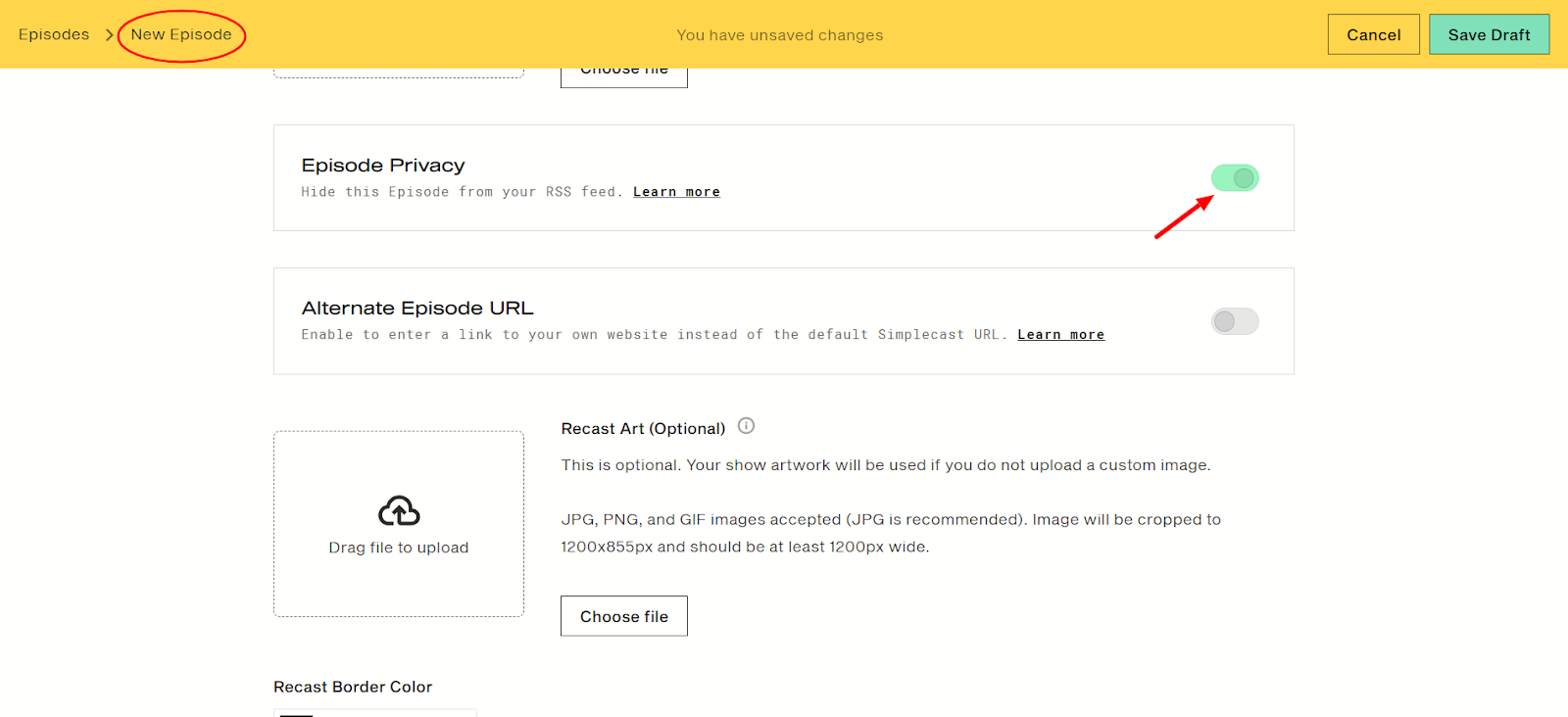
On the contrary, if you already have a publicly accessible podcast, you can go to your Episodes and select the three dots to edit the podcast's privacy settings.
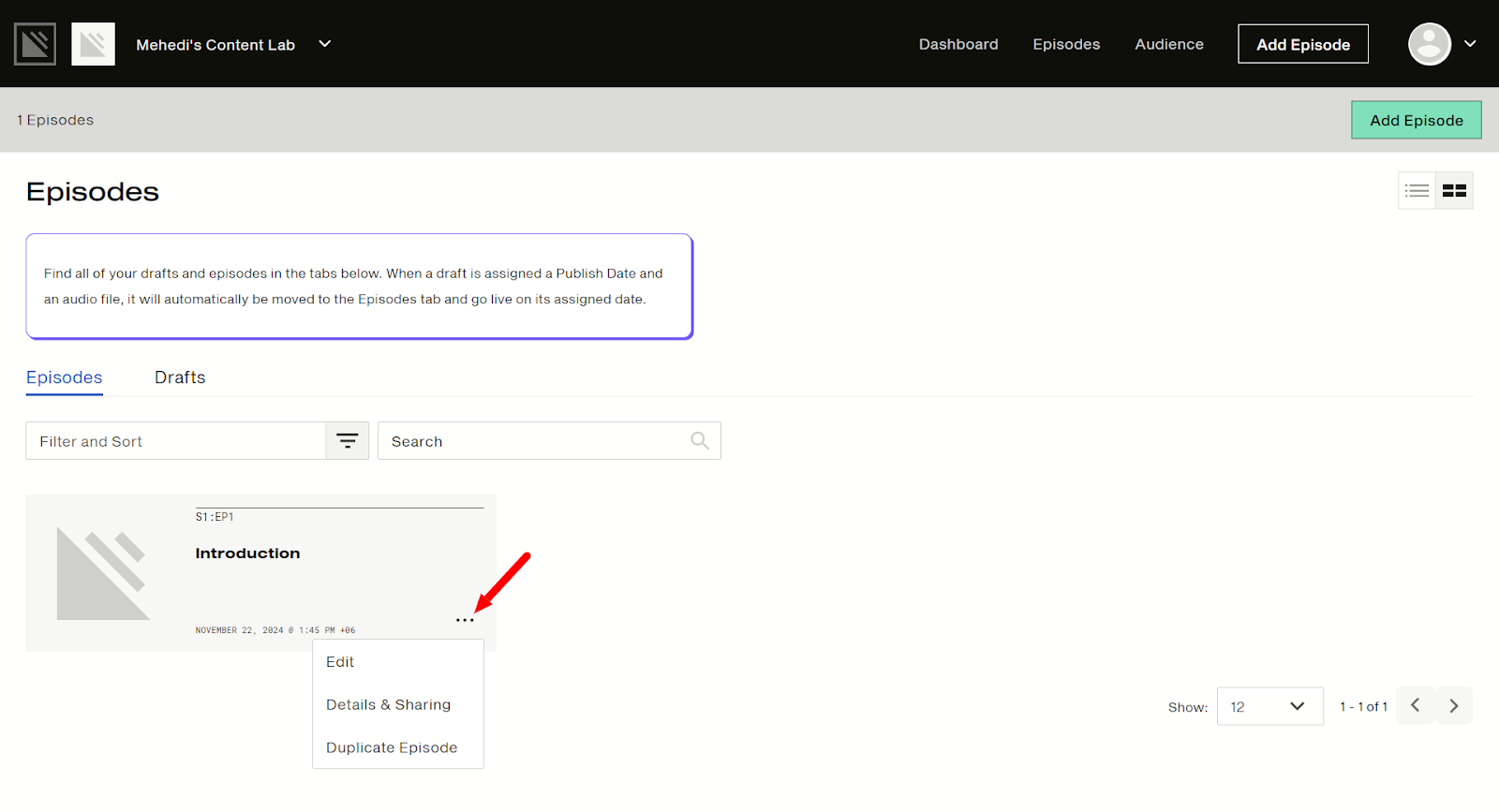
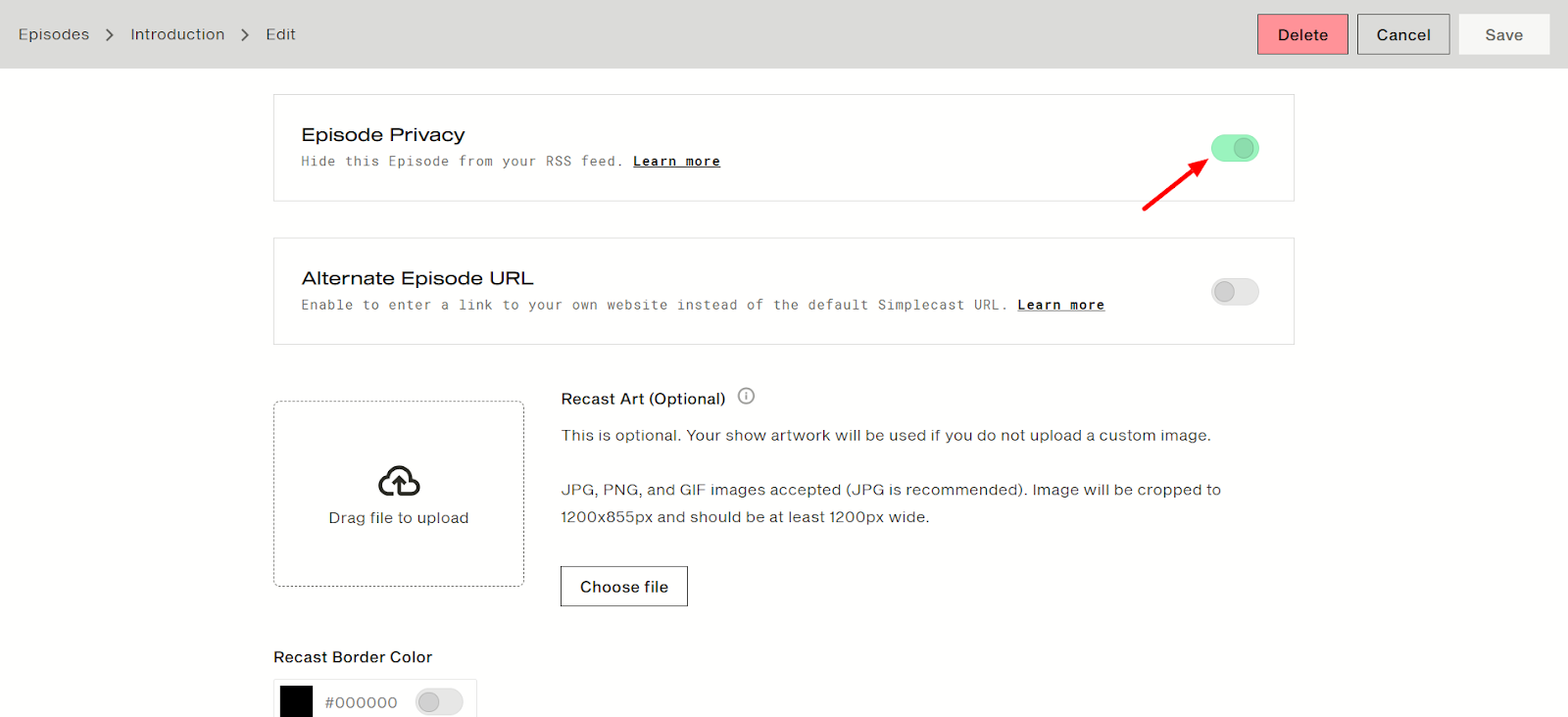
Turn the Episode Privacy button on and save it to confirm the settings and publish the podcast from public to private.
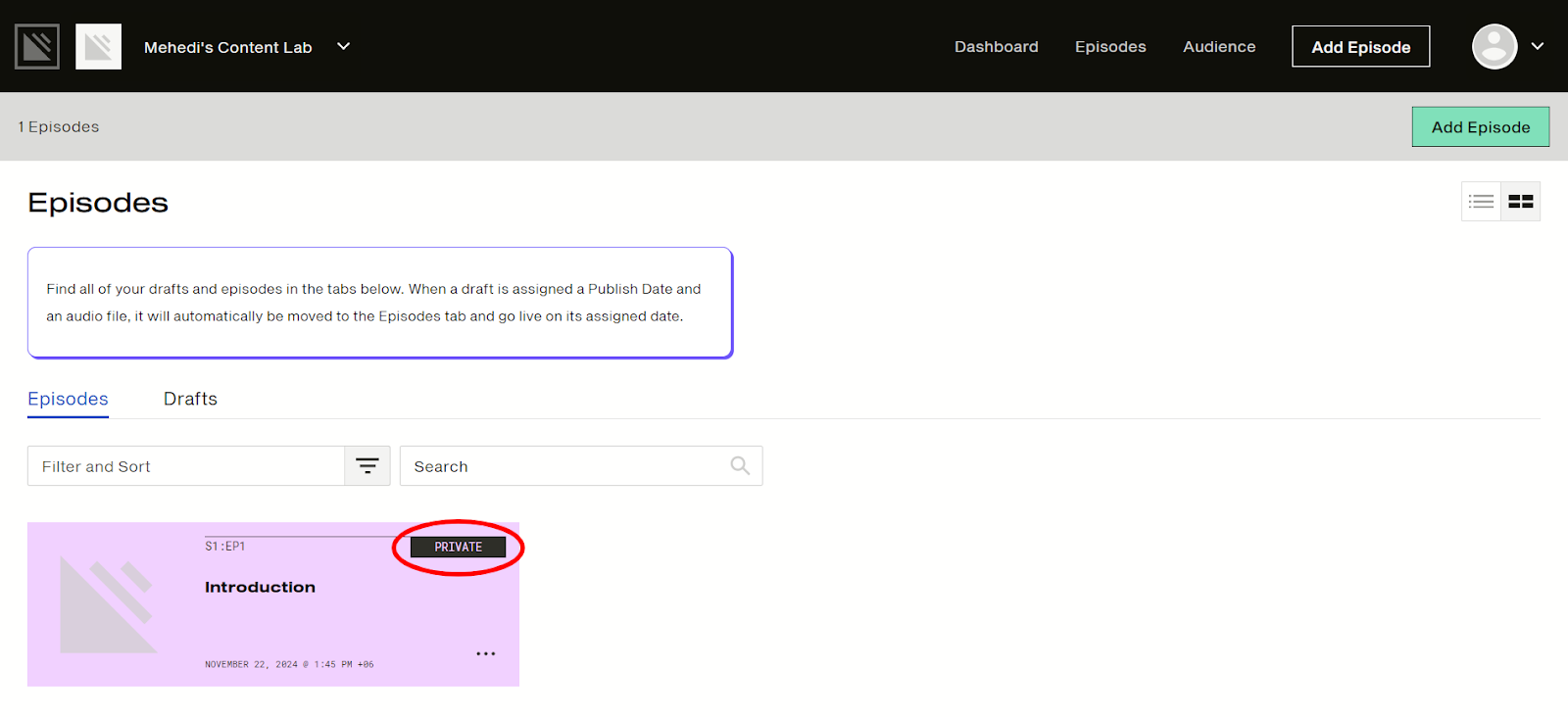
By publishing a podcast privately, you can prevent it from appearing on your Simplecast website, podcasting directories, or RSS feeds. Likewise, the web player will not show the ‘Share & Subscribe’ button.
You have to manually share the podcasts with specific listeners by clicking on the ‘Details & Sharing’ option via the Quick Edit menu (symbolized by three dots on the episode thumbnail). Alternatively, you can share the episode through the platform’s Recast feature.
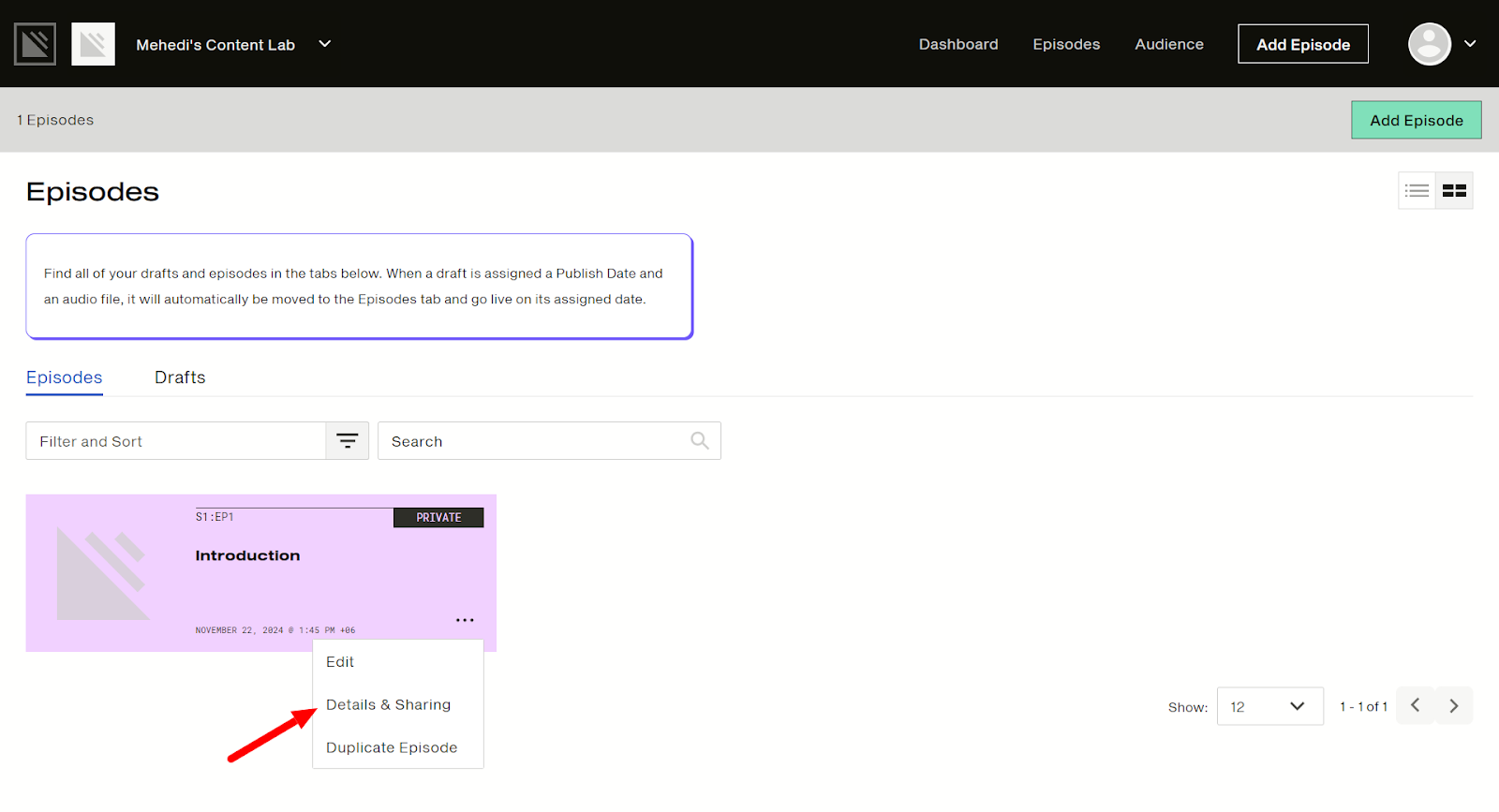
Podcast team creation and management
With Simplecast’s team creation and management feature, you can invite other people easily via email. So, instead of managing your podcasts alone, you can make a diverse team to look after all the key aspects, which improves efficiency and convenience.
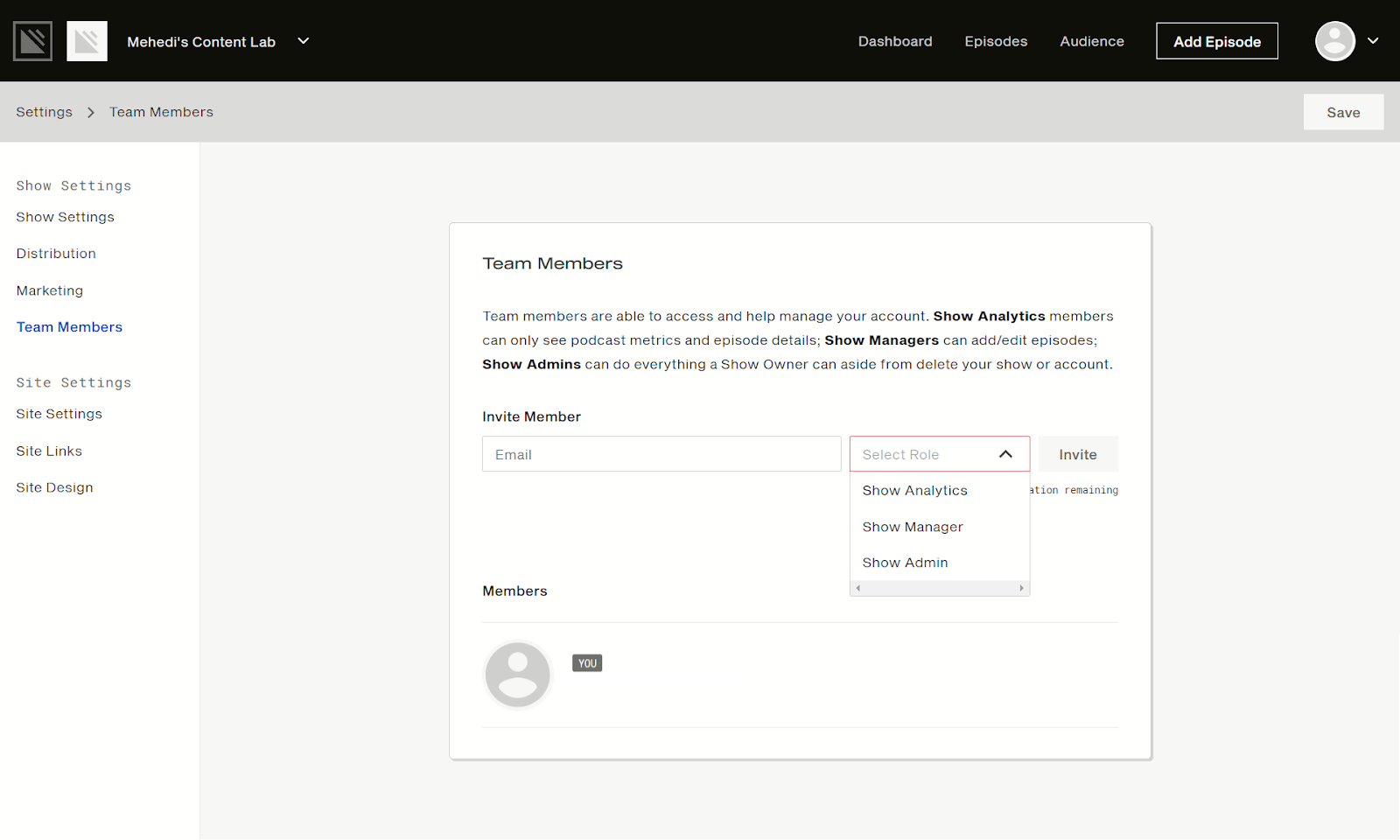
Additionally, you can manage each team member's privileges to simplify the process and eliminate the chances of mistakes. Currently, there are three different permission levels: Analytics, Managers, and Admins.
- Show Analytics members only have access to podcast metrics and general episode details
- Show Managers can only get access to make additions or edits to the episodes
- Show Admins have access to everything a Show Owner does, except the ability to delete your account or show
You - as the Show Owner - can also remove team members at any time.
This can be particularly helpful if you want to downsize or have reached your account's team member limit. The latter, however, can be addressed by upgrading your subscription as well.
Simplecast application programming interface (API)
Sure, there are plenty of podcasting platforms available out there that provide decent options to users in terms of customizations, file uploads, editing, sharing, and other surface-level features.
However, when it comes to the application programming interface, which is responsible for many of the behind-the-scenes functionalities, many of these platforms tend to fall short of expectations.
Simplecast made a robust comeback by introducing the Simplecast 2.0 API, ensuring that the functionalities became more efficient than before so that users could harness the full potential of the platform.
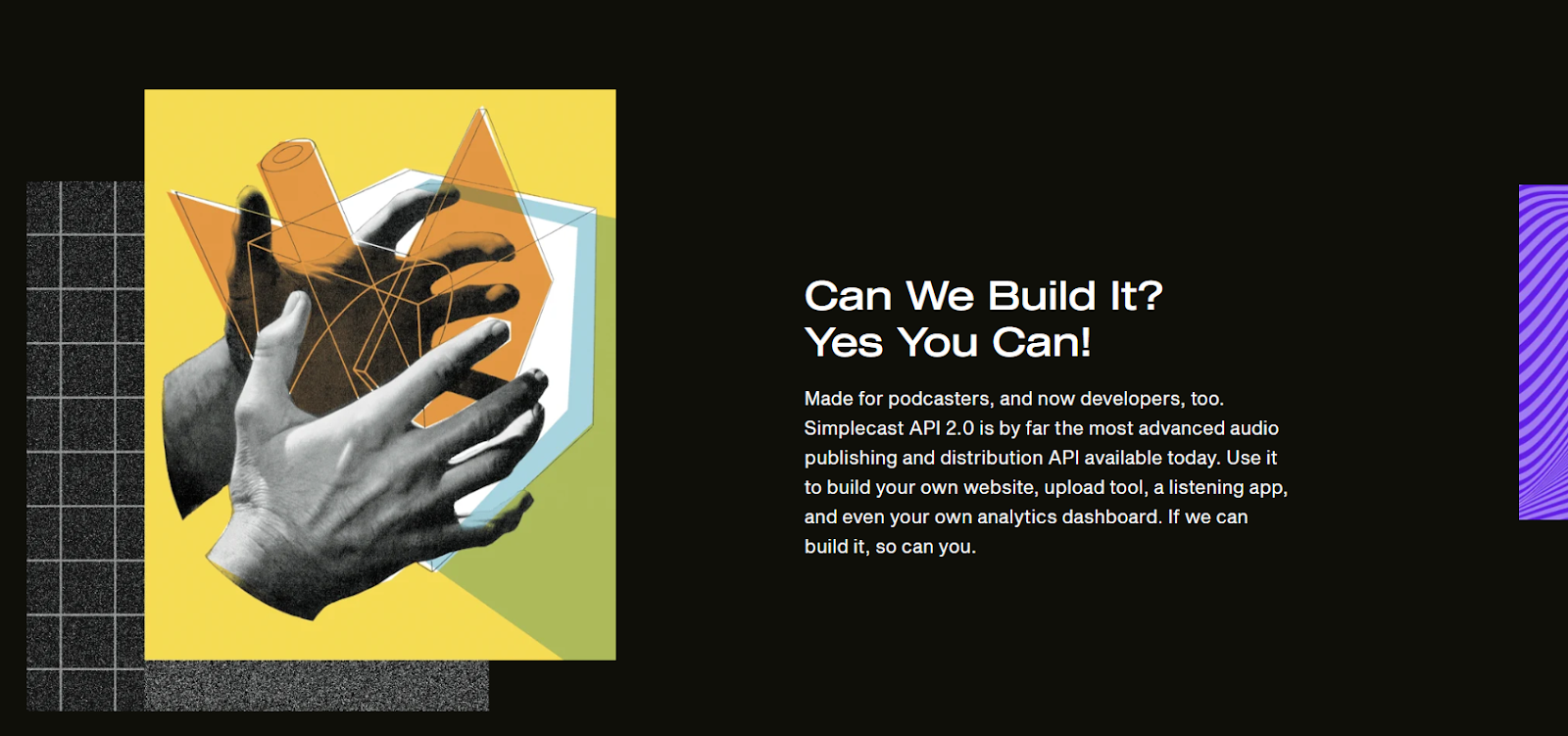
Simplecast API 2.0 is the advanced audio distribution and publishing API that you can use to easily build your uploading tools, website, analytics dashboard, and even your listening app.
It also comes with proper documentation in case you need help. As such, you can manage and monitor almost every aspect of your podcasting experience. However, only the Enterprise Plan has access to API publishing.
File format support
While recording audio isn’t supported on Simplecast, it allows you to upload audio files in various formats, including MP3, mp4a, or WAV.
For the sake of consistency and data efficiency, these files are automatically transcoded to MP3 after the upload is completed. That’s why Simplecast also recommends uploading files in MP3 format.
Speaking of data efficiency, the recommended bitrate for audio files is 128 kbps (kilobytes per second). If you have concerns about data consumption or storage space, you can lower the bitrate to 96 or 64 kbps.
MP3 files support both stereo and mono audio channels, so you can pick the option that best fits your podcast content. While exporting or uploading your podcasts, you can also set the sample rate, bit depth, bitrate type, and loudness standards.
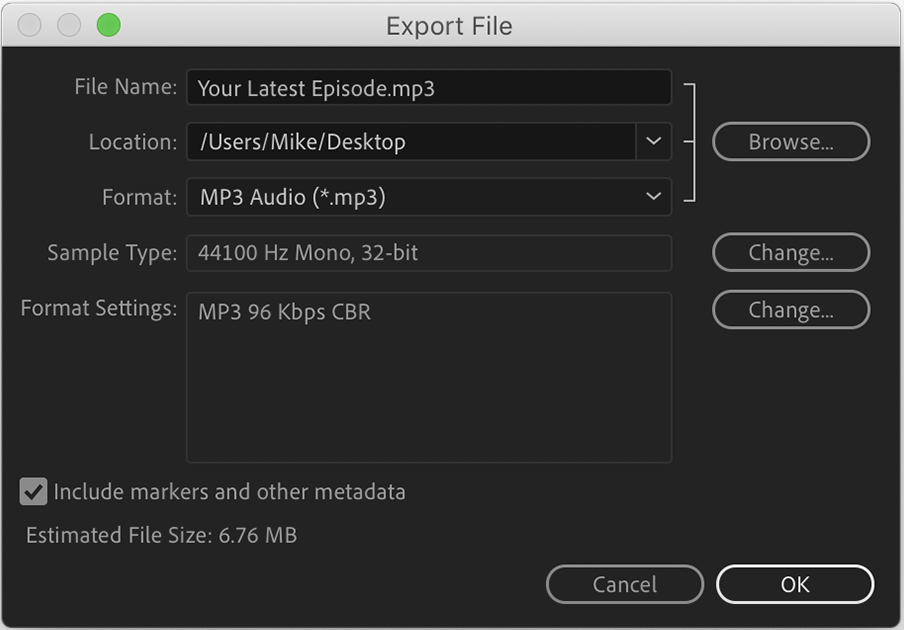
To edit and export your MP3 files, you may need to use third-party software like Adobe Audition, Audacity, GarageBand, etc.
Hosting, distribution, and management systems
One big reason many podcasters sign up for Simplecast these days is its robust framework. It boasts a powerful and versatile hosting infrastructure that anyone can understand.
The core framework is designed to be highly stable and secure, which improves reliability and reduces downtime. Because of that, setting everything up takes very little time, which improves convenience and allows you to focus more of your time on creating the actual content.
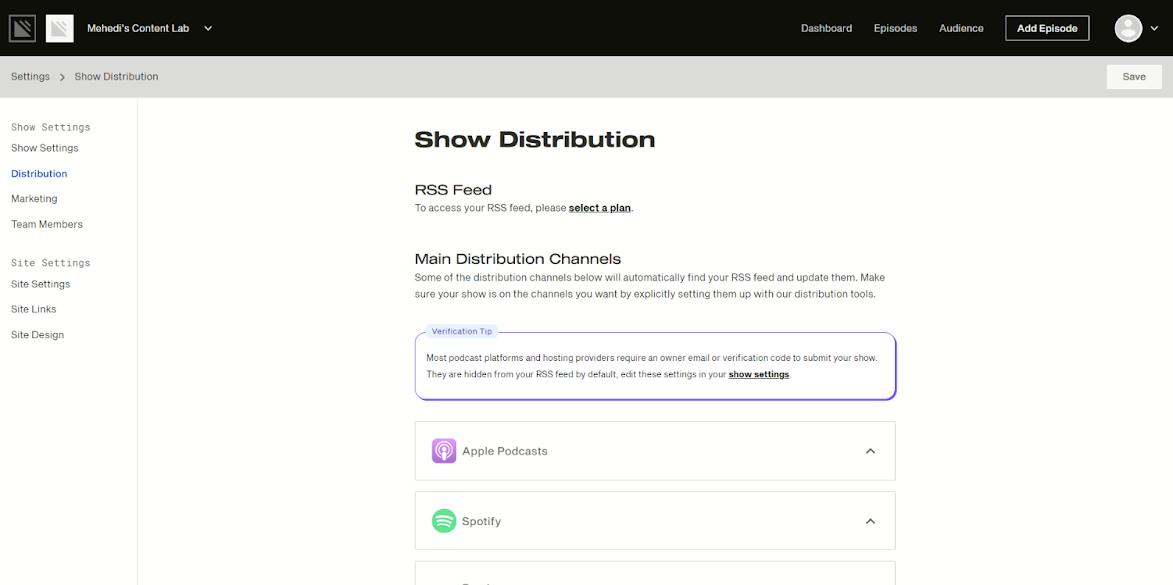
The broadcasting infrastructure is also pretty solid and diverse. It supports distribution on some of the biggest podcast directories today, such as Spotify, Amazon Music, Pandora, Apple Podcasts, and more.
This ensures that your podcast content is easily accessible to listeners worldwide.
Getting your content onto these directories is incredibly easy, and the platform automatically updates your libraries on these apps as soon as you upload new episodes. All you need to do is submit the URL for your RSS feed on these apps, and Simplecast will take care of the rest.
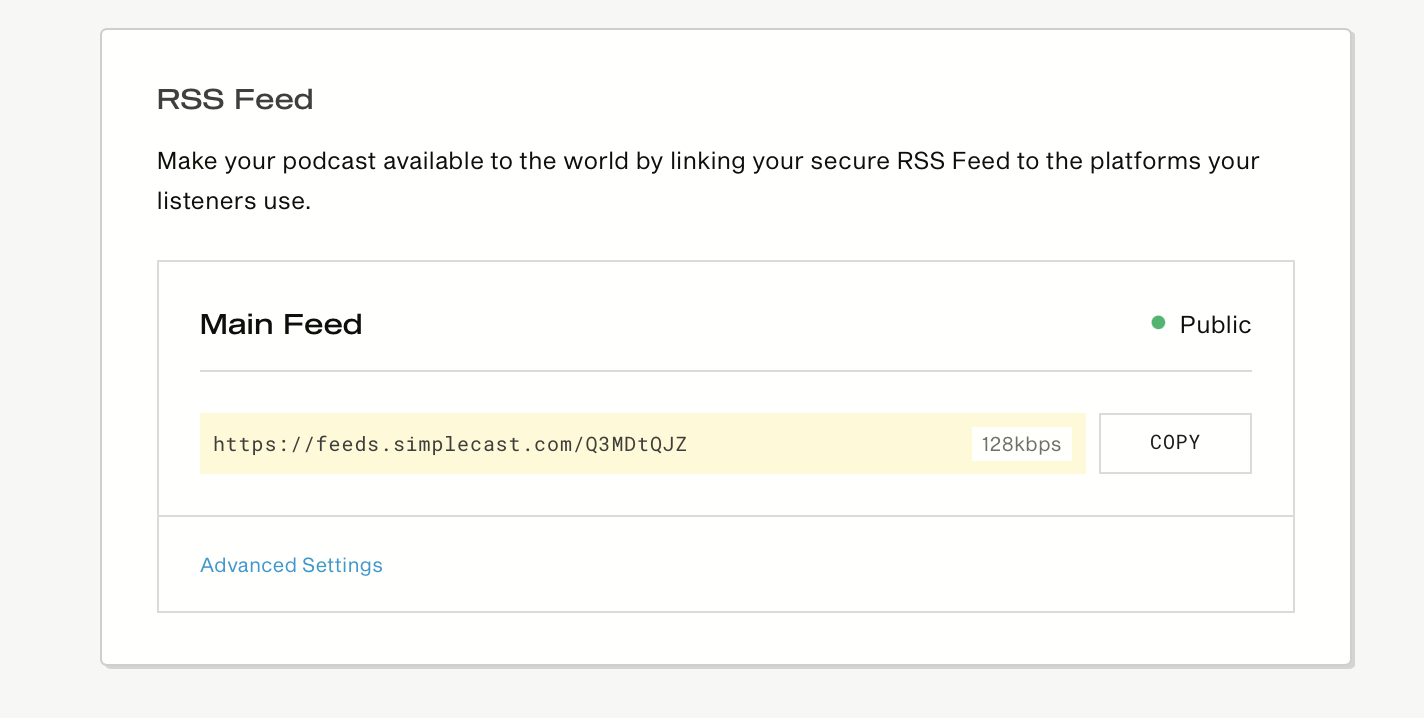
Simplecast is also great for podcast management, which makes it a great pick for those with large podcast libraries. It can be useful for managing multiple podcast shows.
You can conveniently access all your content and shows from your account dashboard, which improves the efficiency of the whole process.
Simplecast tutorial: How to create your first podcast
Now that you know some of Simplecast's key features, you may want to get started as soon as possible.
To make it as easy as we can, we have covered two different tutorials here. One is about starting a podcast from scratch, while the other is about switching from another host to Simplecast.
So, let’s begin!
Starting from scratch
1. Plan and record your podcasts
The first (and most important) step is to plan and prepare your podcast and then record the audio. For the latter, you need to use the correct recording equipment, such as mics, headphones, and other tools.
Next, you need to edit the recorded audio on a DAW (digital audio workstation), such as Audacity, Adobe Audition, or Garageband. Make sure to record and edit a decent number of episodes before moving on to the next step.
2. Set up your Simplecast account
You need to set up your Simplecast account before you can start uploading your files. To do that, sign up for or log in to access your dashboard. If you are a new user, you can also opt for a free trial, as shown in the image.
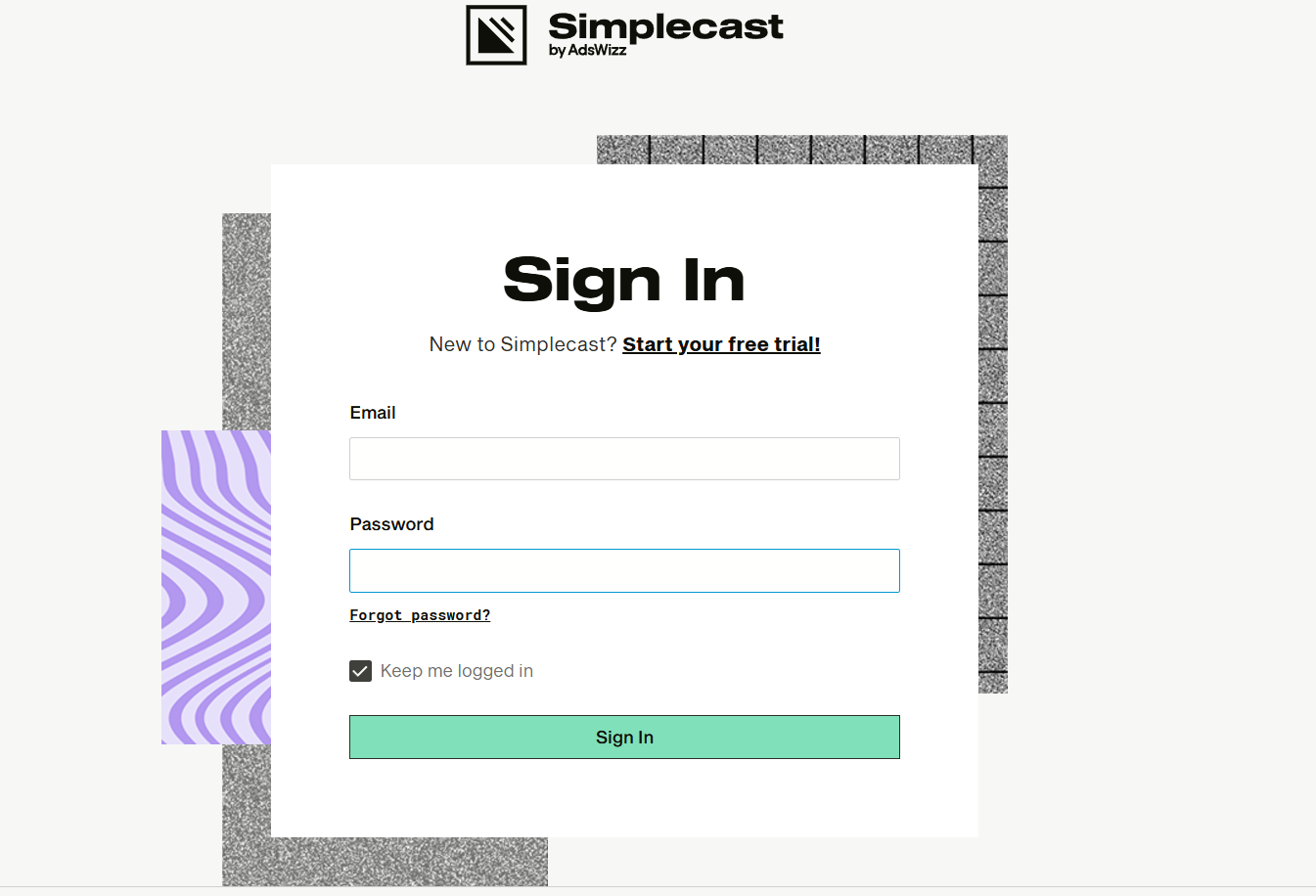
Once you’re done with the first step, this is what you’ll see.
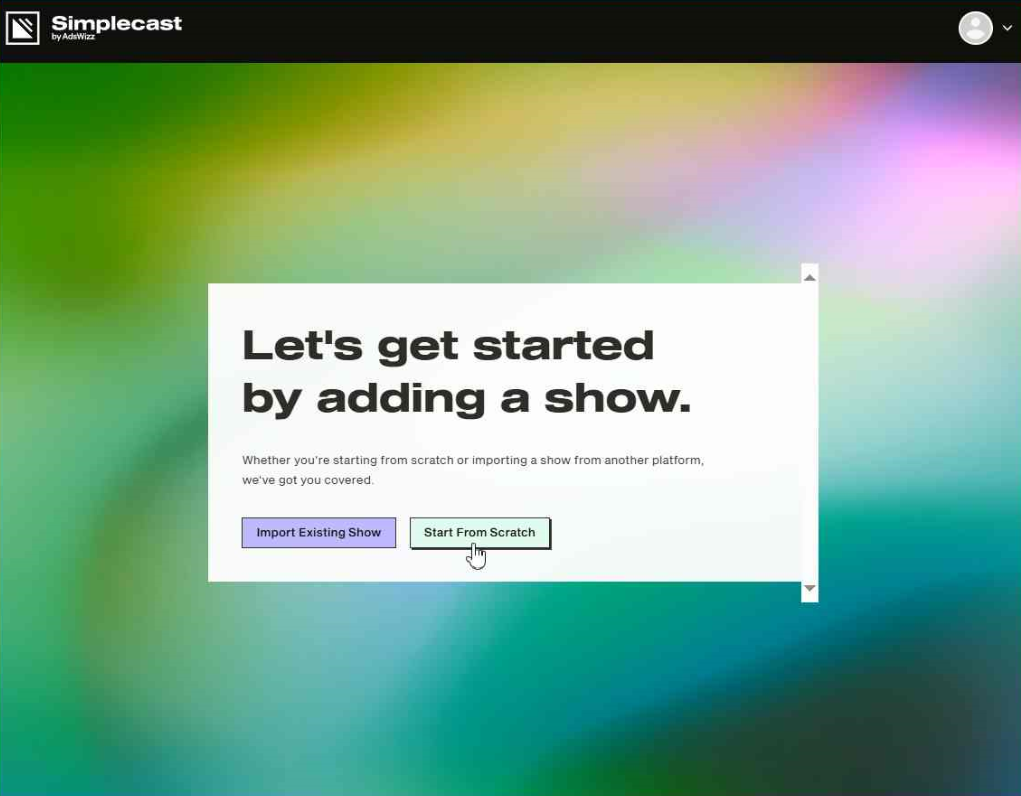
From here, click on the ‘Start From Scratch’ button to start setting up your podcast, as shown in the image. (We’ll also discuss the ‘Import Existing Show’ option later in details.)
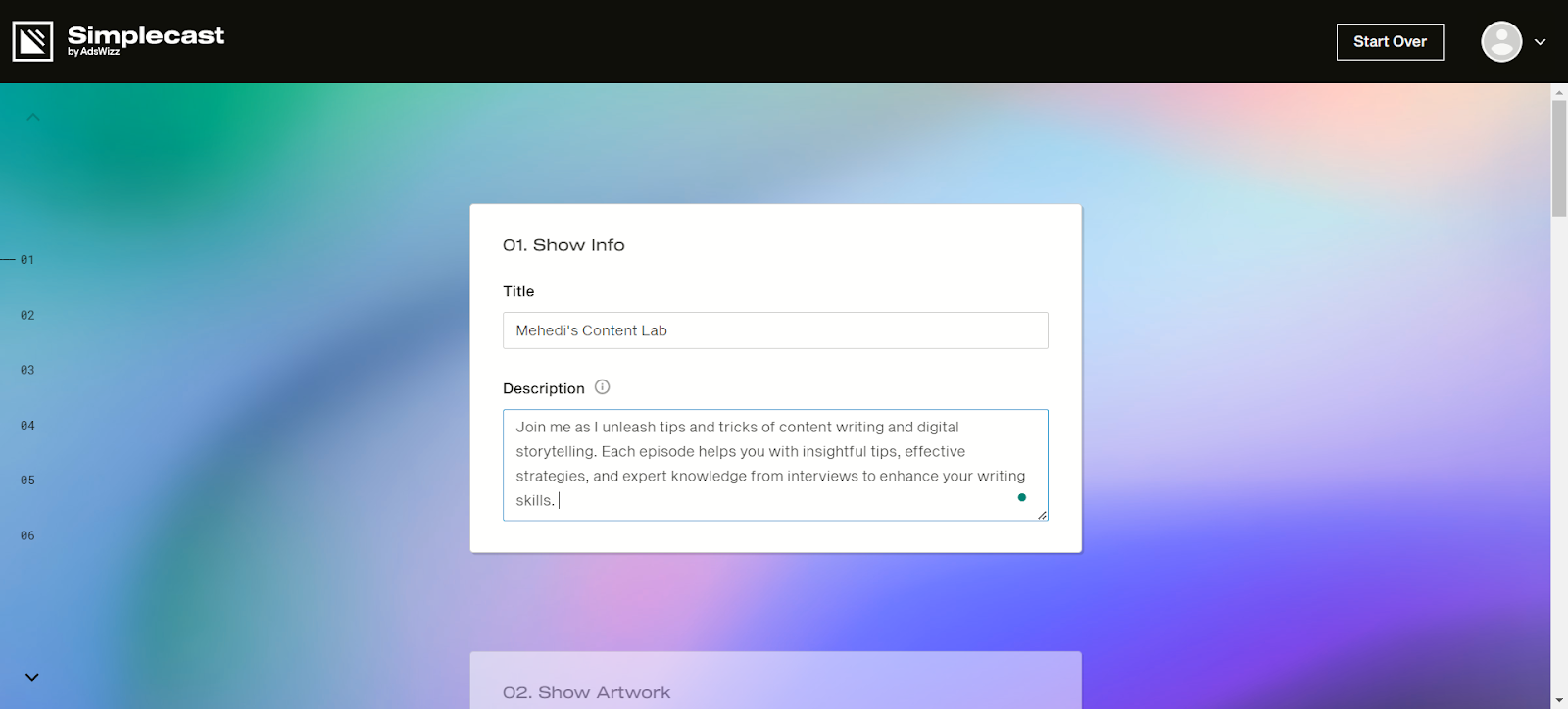
As you can see, you will now need to set up your podcast by supplying the necessary information, such as the Title, Description, artwork, and more.
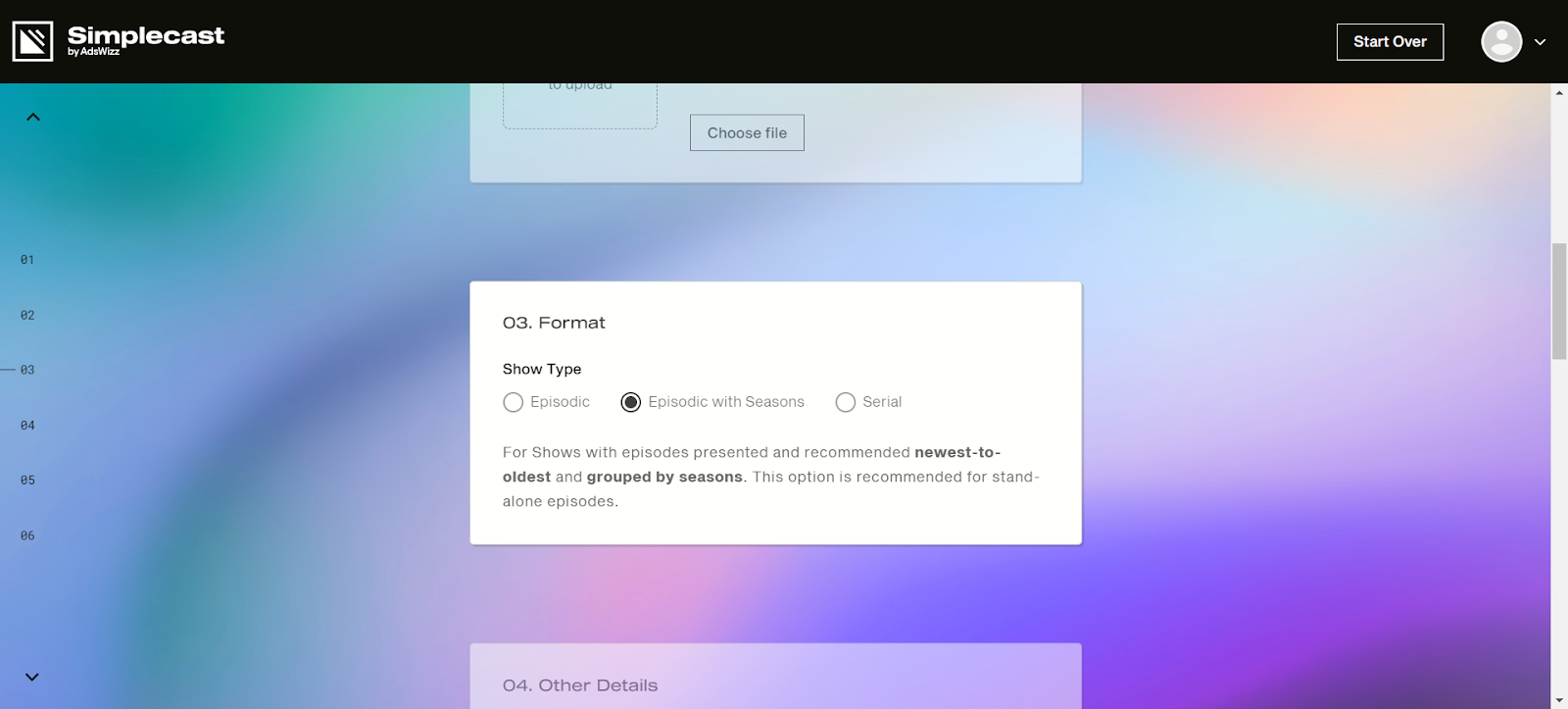
These are some of the requirements you need to fill out.
Don’t worry – this is usually a one-time step for most users unless you skip any step.
Once you have entered the necessary details, click on ‘Save & Preview’ to open a preview page.
Once you verify all the details, click on the ‘Create New Show’ button to start your podcast, as depicted above.
3. Add the episode
Now, your podcast account is ready, and you can start adding episodes to it.
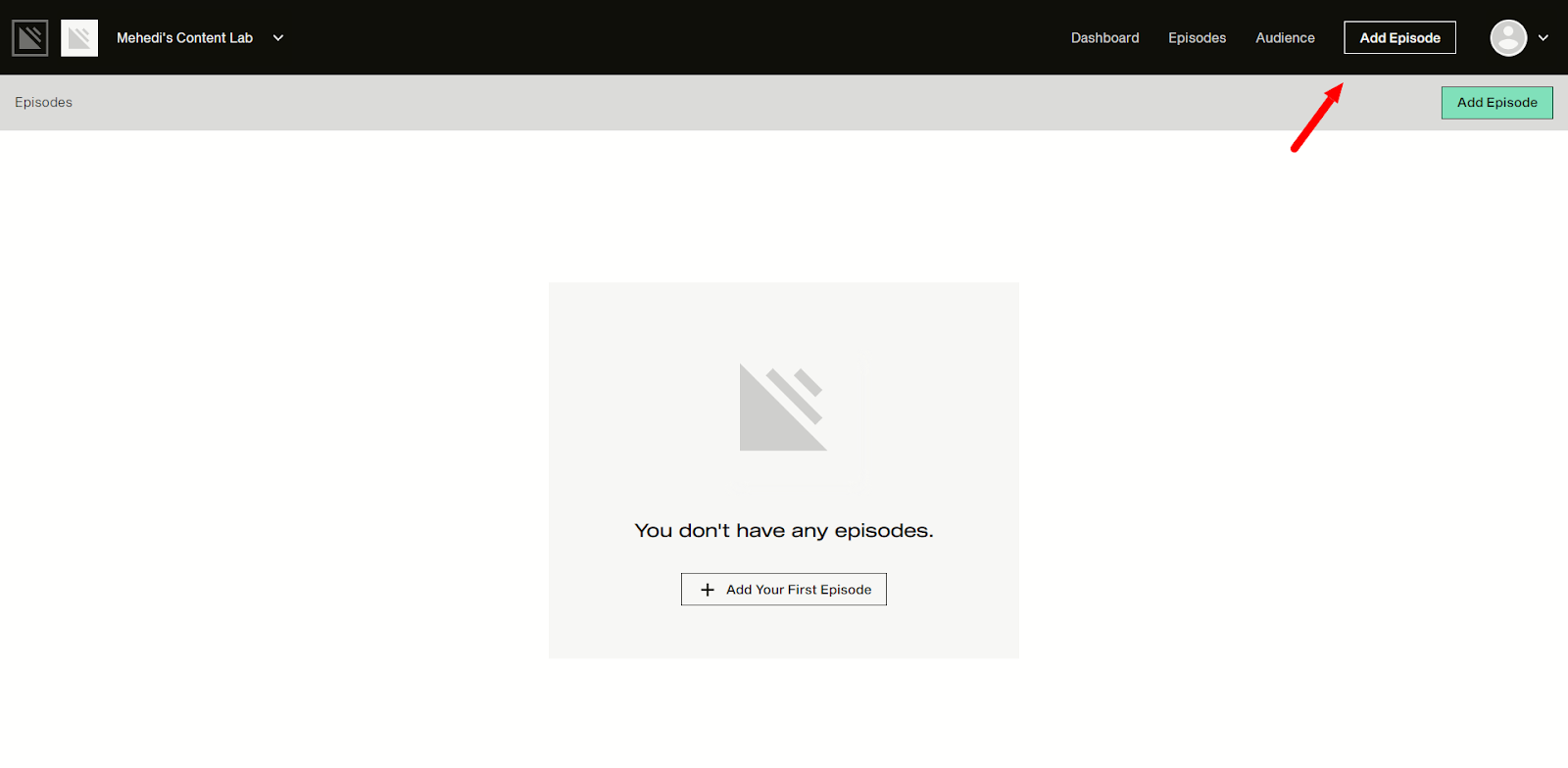
As you can see, you need to click on the ‘Add Episode’ button near the top right corner of your dashboard (located on the black navigation bar). Alternatively, you can go to your dashboard and click on the ‘Add Episode’ button on the ‘Publish an episode’ tile (this is only for the first episode).
4. Fill out the episode details
Next, you will be presented with a detailed form where you need to provide all the necessary details for the episode you wish to upload. These include:
- Episode number
- Season number
- Episode type
- Audio file uploading box (no larger than 1 GB)
- URL slug
- Audio/episode summary
- Episode notes
- Footers
- YouTube Thumbnail
- Episode contributors
- Select episode privacy
- Alternate episode URL
- Recast art and border-color
You can even add unique artwork and keywords for the episode.
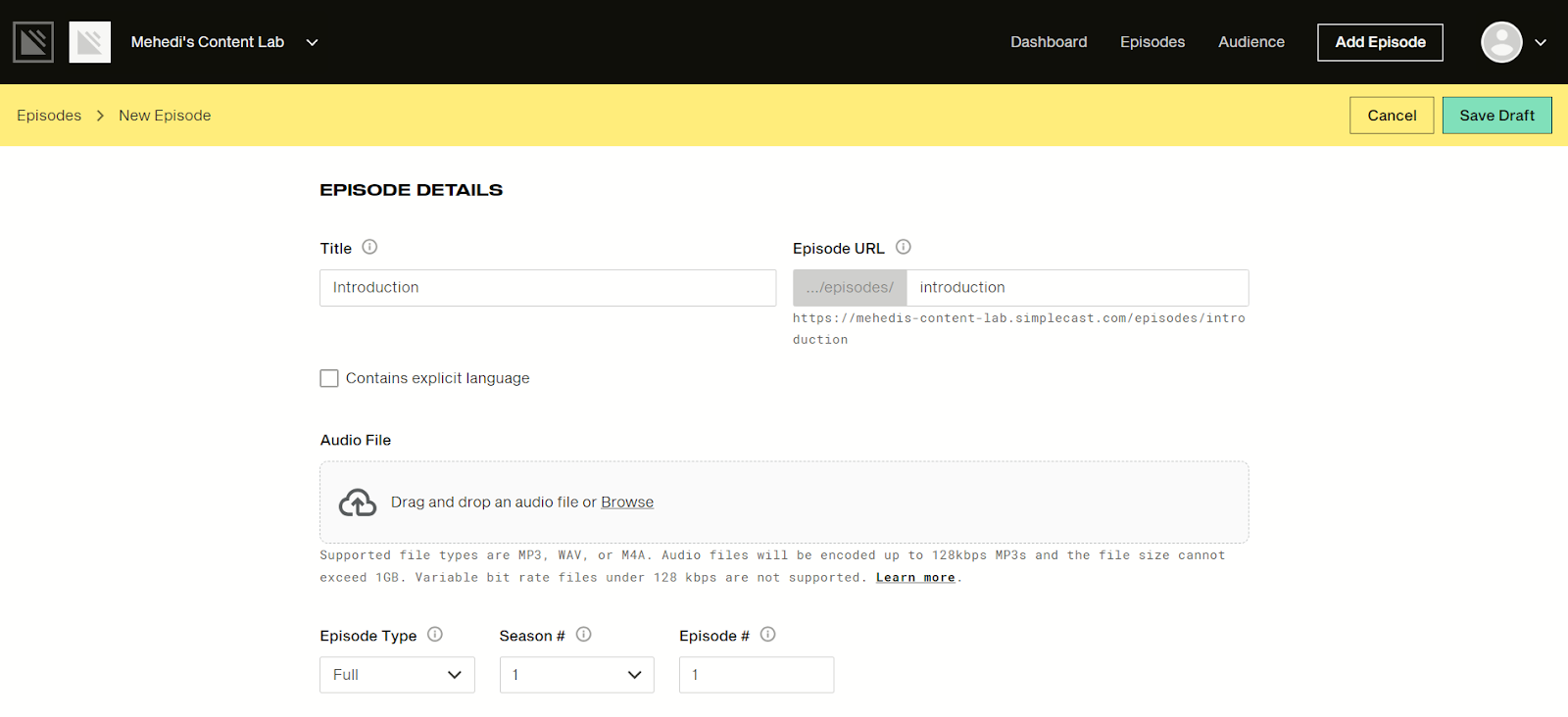
We strongly recommend filling these out since they can help organize your library. While uploading the audio file, remember to fill in the recommended settings shown right under the designated audio file box.
5. Save draft and publish
Once everything is properly filled out, you can click “Save Draft” on the top right corner. This will take you to a page like the one in the image, where you can either schedule the podcast for publishing later or publish it right away.
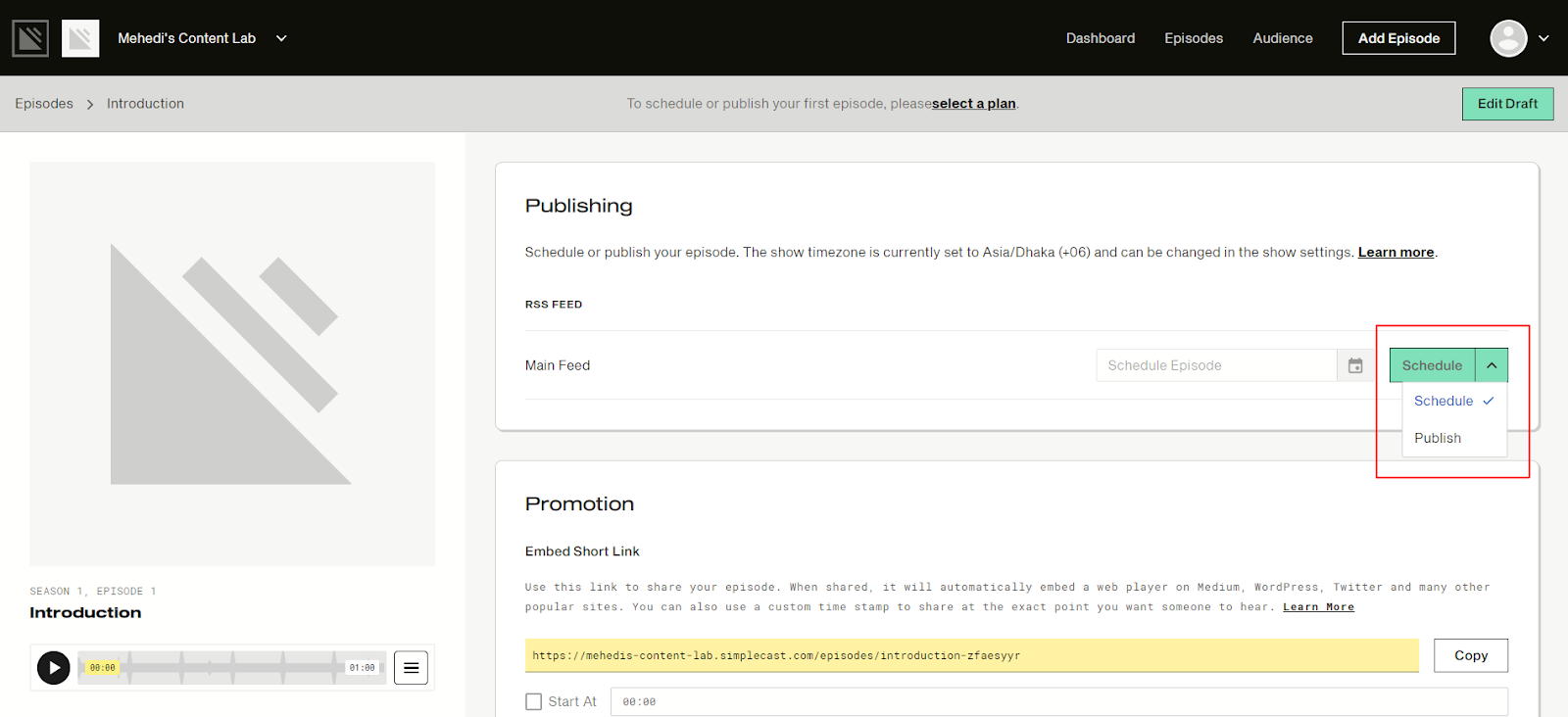
If you want the episode to be automatically published at a later time, you need to select the ‘Schedule’ option. Then, specify the time and date when the episode will go live.
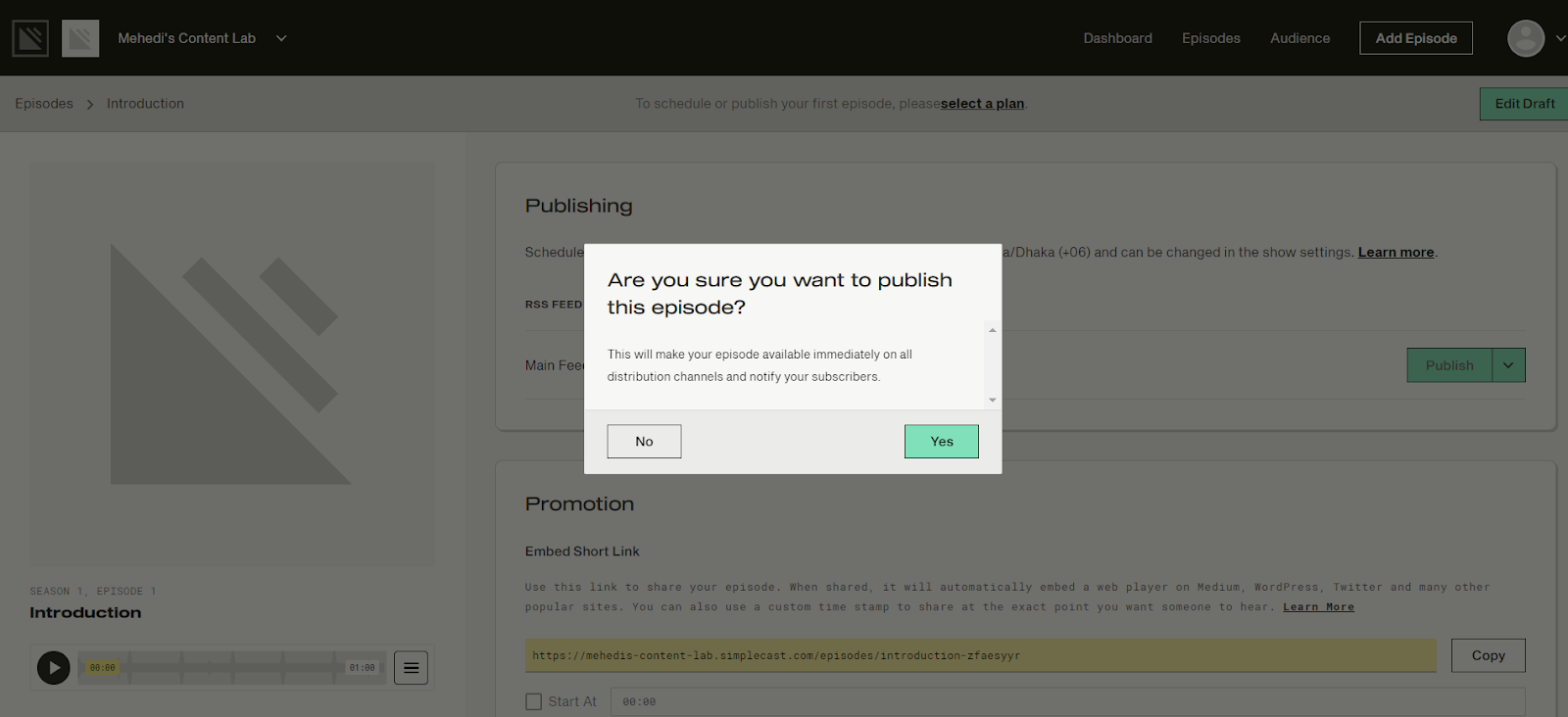
On the other hand, if you wish to publish the episode immediately, select the ‘Publish’ option from the menu. Click on the green button and select ‘Yes’ to publish the episode.
- Standout podcast topic ideas for your next podcast episode!
- Best podcast hosting platforms (including free and low-cost options)
Switching from another host to Simplecast
1. Sign up/log in to your account
Sign up/log in to your Simplecast account using your email and password.
2. Import your podcast
Click on ‘Import existing show.’
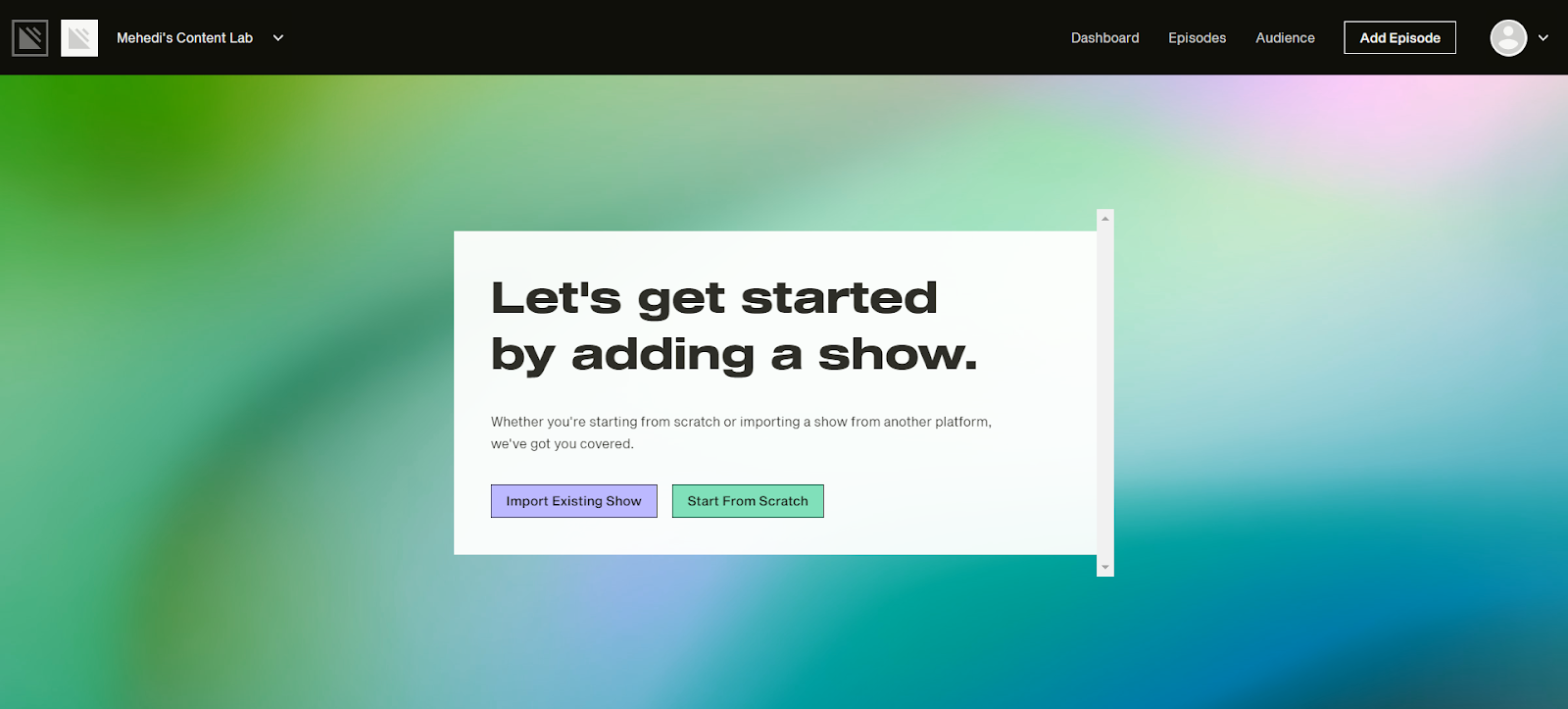
Now, you will be presented with a box that contains an empty text field.
You can either search for your existing podcast by its title, or you can paste the URL for your podcast’s RSS feed. We recommend the latter since conducting a simple search may not always yield the expected results.
Once you have found your podcast, click on ‘Import.’
3. Verify ownership
You will now be sent a verification email to confirm ownership of your podcast. This is a simple security step to prevent any fraudulent acts or content theft. To complete this step, click on the link provided in the verification email.
4. Redirect your old podcast
Once the verification is complete and Simplecast copies your podcast, you will need to log into your old host website and create a 301 redirect for the URL on your old RSS feed.
Ways to promote and monetize your podcast on Simplecast
Now that you know how to set up your Simplecast Podcast, let’s talk about how you can promote your podcasts to gain more listeners. We’ll also be taking a look into the different monetization strategies that you can follow to generate revenues from your podcast.
Short link embedding
Copy the short link of your RSS feed and paste it into relevant web pages. This will automatically embed the web player on the page where people can easily find it and play your podcasts.

This particular promotional strategy is best suited for those who have independent websites and blogs. Embed the RSS feed URL and encourage your WordPress, Medium, or Squarespace site visitors to check out your content.
Sharing on social media
This is another simple promotional strategy that works best for social media platforms. All you need to do is copy the sharing link for your podcast or individual episodes and manually share them on your different social media handles like Facebook, Instagram, Twitter/X.

Recast and web player
Another great promotional strategy for your podcast is to use the Recast functionality. As we have discussed before, Recast is a unique feature of this platform that makes it easy to share short clips from your episodes. Therefore, this strategy can be great for promoting your podcast channel on social media platforms.

However, you can also use the Recast feature to promote the podcast on your websites. Once you paste the Recast sharing link on your web pages, it will create a customized web player for users.
Dynamic ad insertion
With Simplecast, you can insert ads dynamically into your episodes, allowing you to manage ad placement flexibly. This helps ensure you have control over updating and swapping out ads as needed.
Affiliate marketing
If you are a relatively new podcaster with few listeners and limited resources to spare, affiliate marketing via retail platforms like Amazon, eBay, and others can be a decent strategy.
You can sell products relevant to the podcasts on these platforms and generate commissions for every sale generated through your affiliate link. This can accumulate over time and provide you with a steady income flow.
Paid content
Offer premium podcast episodes for a certain amount, catering exclusively to the subscribers. This helps ensure you have a committed and loyal listener base. However, make sure to maintain a good balance with the free content to make the non-paying listeners feel included.
AdsWizz marketplace
AdsWizz podcast marketplace enables immediate Simplecast monetization. This marketplace is one of the largest digital marketplaces for purchasing and selling podcast advertising inventory. The platform also offers a comprehensive range of features designed for publishers and advertisers.
Listener donations
Another tried and tested strategy of monetization for beginners is accepting donations from existing listeners. If your content is well-made and engaging, it won’t be difficult to attract loyal listeners who will be more than happy to donate money on a regular basis.
Podcast collaborations
If your podcast has a moderately high number of listeners, you can use a collaborative approach to grow and monetize your channel. Collaborating with other similar podcasters from your niche will give your channel (and theirs) additional exposure.
This will naturally attract new listeners, translating to more downloads, likes, comments, shares, and overall engagement on your episodes – ultimately generating passive income for your channel.
Sponsorships
Do you have a podcast channel that is already well known and has a large listener base?
You can use sponsorships to capitalize on them and boost your earnings. Established brands are always looking to sponsor episodes of influential podcasters.
To land a decent sponsorship, you have to understand your audience really well (particularly their interest and demographics). This is also crucial to create high-performing ad campaigns.
- How to get podcast sponsors (and where you can find them)
- How much money do podcasters make? A guide to podcast monetization
Simplecast pricing options
Now, let's discuss how much it will cost you to host your podcasts on Simplecast.
Before we get into the details, know that if you don’t want to pay for the platform initially, Simplecast offers a free 14-day trial period to all of its first-time clients.
This is a great feature, considering you can check out the platform to see if it suits your needs.
You can choose between two subscription tiers suitable for independent podcasters – Basic and Essential. As the name suggests, the Basic subscription is the lowest tier, available for $15 per month, offering the bare minimum of features and tools.
It’s good for independent podcasters who are just starting out on their podcasting journey.
If you want more features, you can pay $35/month and get the Essential subscription. This tier comes with several useful tools in addition to all that is offered in the Basic subscription. This is the perfect fit for those who want to grow their podcast quickly.
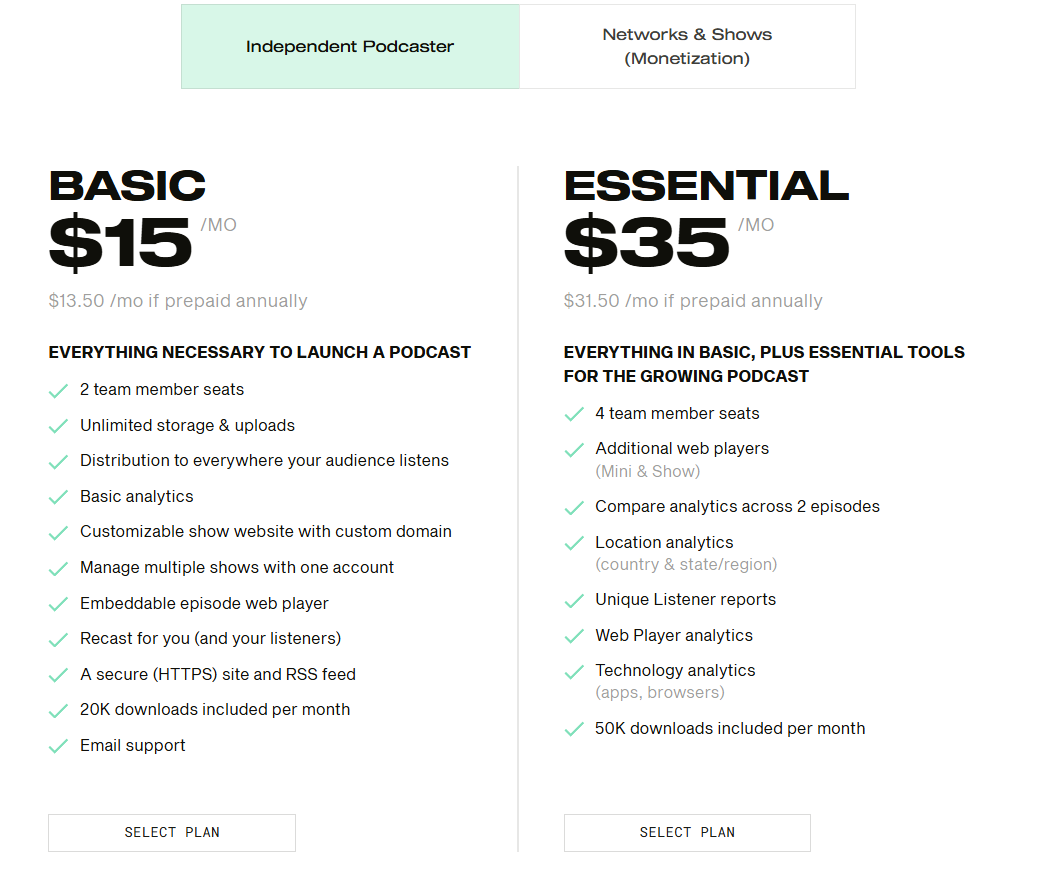
Aside from these two, which are primarily aimed at independent podcasters, there are two more subscription plans for established podcasters with an already diverse network.
The Professional subscription plan offers all the benefits of the Basic and Essential plans, plus many enterprise-level features suited for large podcasters. Then, there's the Enterprise Add-Ons plan, which offers a range of customized features that can make it easy to manage a large podcast network.
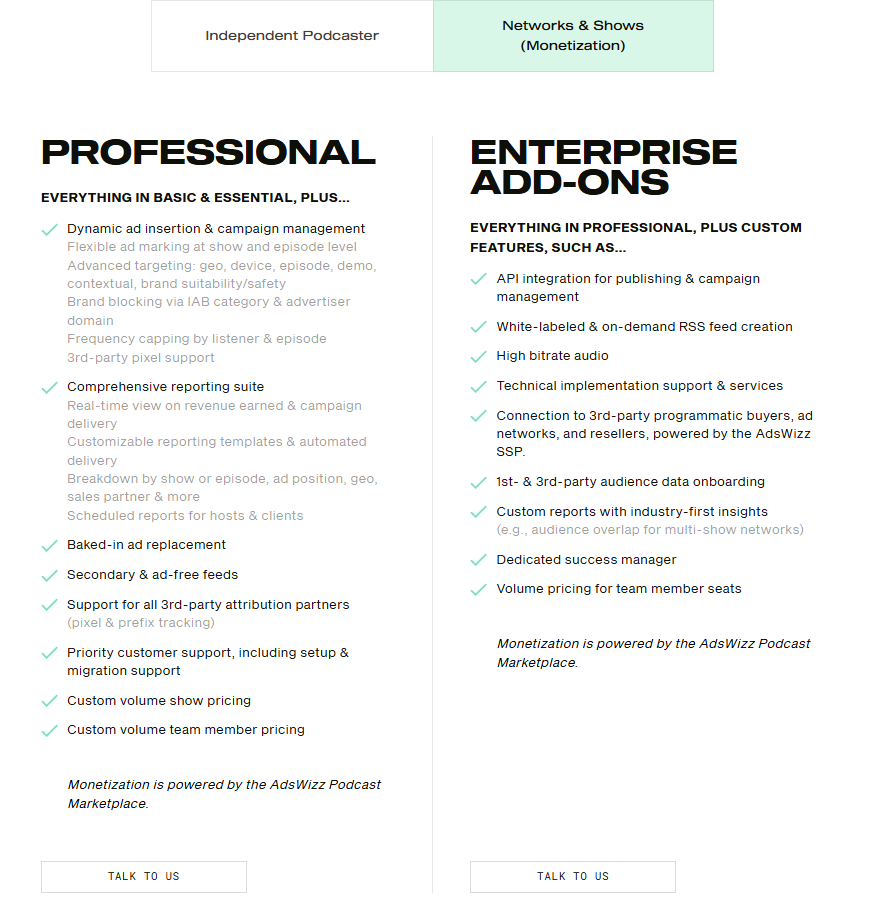
As you can see, these two plans don’t have set pricing, which means that you will need to contact the Simplecast support team to discuss the price.
What do others say about Simplecast?
Let’s see what other users think of Simplecast. The following reviews are from G2.
Review from Lohitha B
Media Broadcaster, Mid-Market (51-1000 employees)
Rated Simplecast: 5/5
"Podcasting at its best"
What do you like best about Simplecast?
Pretty good email support.
The subscription is divided into three sections, making the users choose wisely.
They even contain a separate subscription for networking and business users.
What do you dislike about Simplecast?
Some subscriptions are not worth the features they offer.
Many features are similar in each subscription, making the user think twice about opting for a higher subscription.
Review from Samantha B
Senior Specialist, Brand Marketing, Mid-Market (51-1000 employees)
Rated Simplecast: 1/5
"No Product Roadmap Accuracy or Transparency"
What do you like best about Simplecast?
We chose Simplecast because they're easy to use and reasonably priced, offered unique social sharing functionality (Recast), and were recommended to us by another podcaster.
What do you dislike about Simplecast?
We were promised that the new version of the Simplecast platform would eliminate the downsides we saw (limited analytics, etc.) when we first subscribed, and that it would be delivered about a month after we signed on. That initial promise was for delivery in August of 2018. It's now April of 2019, and we STILL don't have the new version (though others do, and all new members have it by default).
I've had to reach out to support several times to get updated timelines, and they've always under-promised and missed their own updated deadlines, requiring me to reach out repeatedly.
Finally, I've been told that we can be migrated, but it comes with several caveats no one warned us about beforehand (including limited sponsor visibility in the new platform, which we can't reconcile for our sponsors because they've been promised more; removed support for custom CSS on our podcast website via Simplecast; and others).
As a marketer for a software company, it baffles me how much misinformation we've been fed about this release—from the timeline (which is now 8 MONTHS off of what we were first promised) to the migration process and the limitations of the new setup. At this point, I have very little trust in the Simplecast team, and thus can't in good conscience recommend them to others. We've invested in this platform, and it appears we're stuck with a dud until they get their development roadmap together.
Should you use Simplecast?
Now you know most of the details about Simplecast, namely its features, setup, and pricing - should you use this platform for podcasting?
Given the range of features, it’s surely a good enough option for most podcasters. However, before you decide to go for the paid plans, make sure to check out the pros and cons of this platform.
Reasons to use Simplecast
- Simple and easy to use: The features and user interface of Simplecast are incredibly easy to understand and use
- Convenient content migration: It is very convenient to switch to Simplecast from another podcast-hosting platform
- Highly customizable: Simplecast allows you to customize different aspects of your podcast channel, such as your profile, podcast website, and even the web player.
- Team and content management: The content and team management features of Simplecast are highly intuitive
- Easy sharing: Sharing your podcast content on different platforms and social media channels via Simplecast is incredibly easy, thanks to Recast and other sharing tools
Reasons to avoid Simplecast
- Automatic transcoding: The auto-transcoding functionality from the lossless M4A and WAV formats can be disadvantageous for many veteran podcasters
- Lack of support for video podcasting: The platform does not offer any video podcasting features, which limits the range of content you can upload
- Download and bandwidth limits: Simplecast enforces strict bandwidth limits for its downloads, which can act as a hindrance for large podcasters
- Limited file size: Simplecast only allows files up to 1 GB to be uploaded
- Limited monetization capabilities: The scope for direct monetization is limited, which means podcasters need to resort to alternate monetization strategies like branded merchandise and sponsorships
- Slightly expensive: Simplecast's pricing plans are relatively expensive compared to other similar platforms.
Based on the above, we believe Simplecast is a great choice for beginners and intermediate-level podcasters. However, once your channel grows in popularity and has a volume of content, you may start to notice the drawbacks of this platform despite the range of advanced features it offers.
Also, the lack of a robust monetization framework may hurt your earnings in the long run.
A solution to this would be pairing your podcast with Whop, a platform that helps creators monetize through subscriptions, exclusive content, and bundled offers. Whop simplifies payment processing and customer management, giving you new ways to grow your revenue effortlessly.
3 Simplecast alternatives to consider
If you think Simplecast might not meet your requirements at some point, take a look at these three alternatives to Simplecast.
1. Anchor
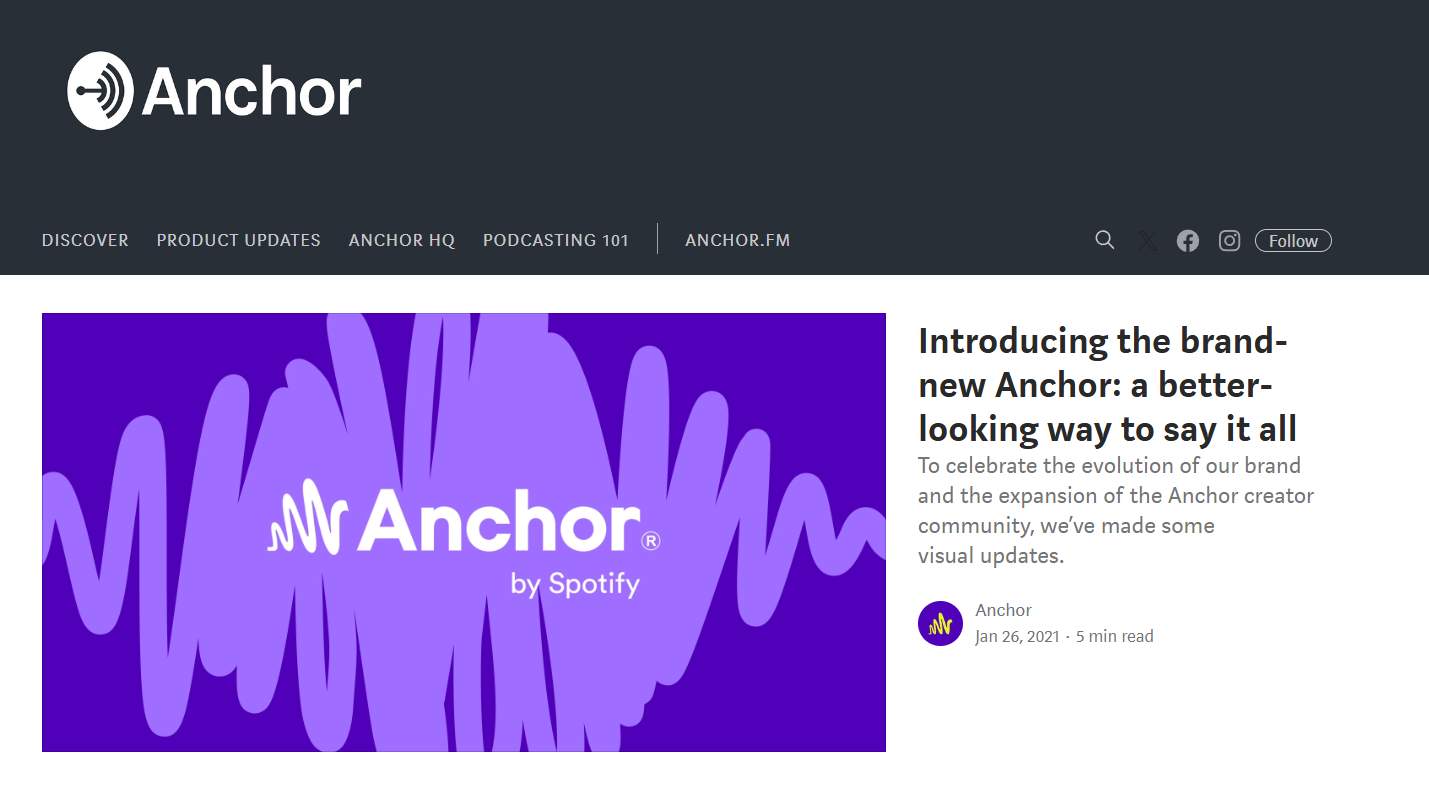
This platform's biggest benefit is that it’s free, which makes it a great pick for those with strict financial restraints.
Since it doesn’t cost any money, you can use this platform for casual podcasting purposes. You can also learn a lot about the basics of podcasting without any risks. What’s more, Anchor is owned and operated by Spotify, which means that you get decent exposure for your podcast even without going on other podcast directories.
However, the features and tools offered by Anchor are quite barebones and do not have the same level of polish as the ones offered by Simplecast.
Also, if you are a veteran podcaster, you may find Anchor’s Terms of Service to be quite unfavorable, particularly when it comes to content ownership rights.
| Feature | Simplecast | Anchor |
|---|---|---|
| Pricing | Starts from $15 | Free |
| Analytics | Offers detailed analytics | Only basic analytics are available |
| Monetization | Affiliates, sponsorships, donations, collaborations | Audience donations and advertisements |
| Content limits | Unlimited storage and uploads | Unlimited storage and uploads |
2. Podbean
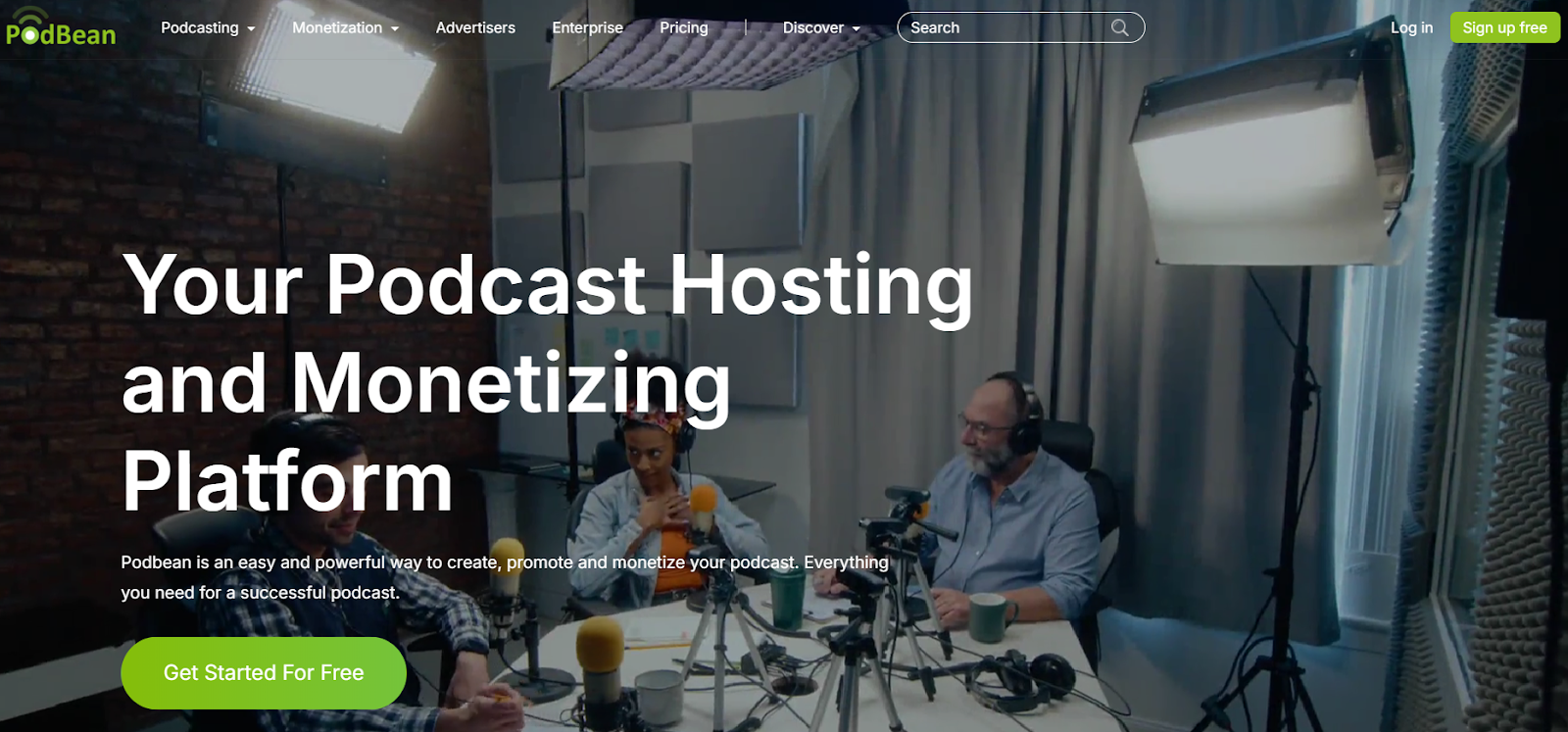
Podbean is another excellent alternative to Simplecast, offering a range of useful features for growing podcasters. It’s much more affordable than Simplecast, which is an advantage for new and moderately experienced podcasters. Also, it offers unlimited hosting and free storage of 100GB, making it a great pick for beginners.
However, if you are a professional podcaster, the 100GB storage may feel limited for your needs. Also, while the analytics offered by Podean are quite detailed, they are not as comprehensive as Simplecast.
| Feature | Simplecast | Podbean |
|---|---|---|
| Pricing | Starts from $15 | A free basic plan; paid plans start from $9 |
| Analytics | Offers detailed analytics | Intermediate-level analytics offered |
| Monetization | Affiliates, sponsorships, audience donations, collaborations | Audience donations and sponsorships |
| Content limits | Unlimited storage and uploads | Unlimited storage and uploads |
3. Buzzsprout
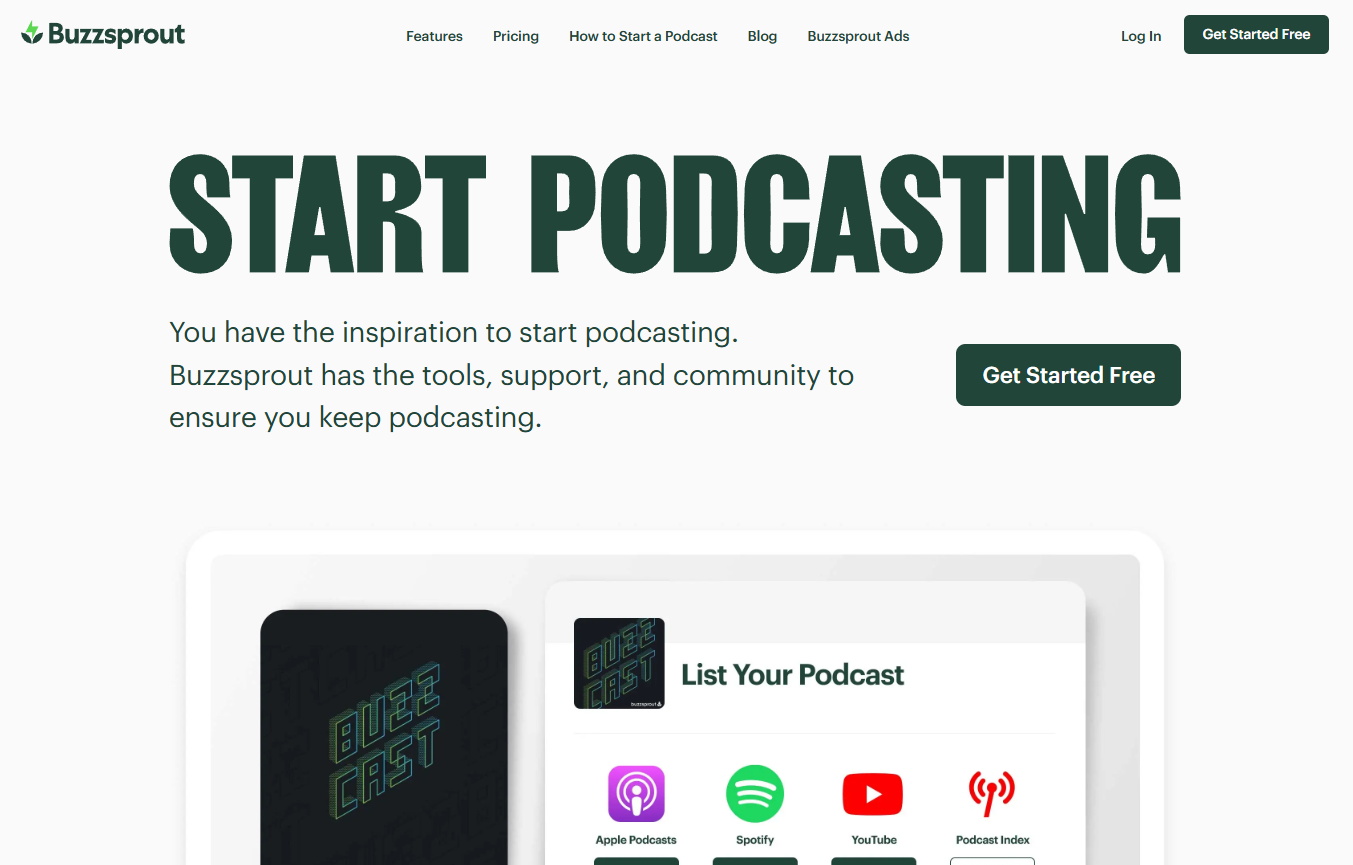
Again, if you are an experienced podcaster looking for a better alternative to Simplecast, then you should definitely consider Buzzsprout. It provides its users with a comprehensive range of features that match those offered by Simplecast but at a more affordable price point.
Furthermore, it offers a fully functional free plan instead of a timed free trial, making it a great option for beginners. It also has a stronger monetization system than Simplecast.
A major setback for Buzzsprout is its data upload limits. As a seasoned podcaster, you might not feel very thrilled about this, but you can always bypass this restriction by paying an additional fee. Also, beginners can’t have access to certain advanced analytic features as they require higher subscription tiers.
| Feature | Simplecast | Buzzsprout |
|---|---|---|
| Pricing | Starts from $15 | A free basic plan; paid plans start from $12 |
| Analytics | Offers detailed analytics | In-depth analytics available at higher subscription tiers |
| Monetization | Affiliates, sponsorships, donations, collaborations | Monthly subscriptions, audience donations, and advertisements |
| Content limits | Unlimited storage and uploads | Unlimited storage, uploads limited by a set duration per month |
Monetize your podcast with Whop
It doesn’t matter whether you choose Simplecast or another suitable podcasting platform - your primary objective should be to efficiently host and monetize your podcasts so that you can generate revenue from them.
That’s why it’s always wise to monetize your content using a comprehensive platform such as Whop.
In addition to monetizing your podcast, you can grow your community and gain greater exposure with Whop. You can sell any kind of digital product, including courses, ebooks, coaching programs, templates, community memberships, and much more.
With Whop, you create your own internet hub (called a whop) and give your listeners a place to connect, engage, and purchase. With it, you get a range of monetization options for your podcast, such as:
- Creating a paid community for VIPs
- Selling private or custom content to exclusive members
- Accepting fan donations
- Selling extra goodies and merchandise
- Affiliate marketing opportunities
- Free exposure to Whop's organic traffic
Since many of the above monetization options are not available directly in Simplecast, it can be an excellent idea to pair it up with Whop. That way, you can get an additional channel to earn money when creating interesting Simplecast podcasts.
You can decide how you want to monetize your podcast. Whether you want it to be free, paywalled, or a little bit of both - it's all possible with Whop.
On top of this, it's completely free to sign up - Whop's fees start at a tiny 2.7% + $0.30 of revenue.
Don't wait, monetize your podcast on Whop today.
FAQs
Can I monetize my podcast directly through Simplecast?
Simplecast offers several monetization options, including dynamic ad insertion and access to the AdsWizz marketplace - one of the largest digital marketplaces for podcast advertising. However, direct monetization capabilities are somewhat limited compared to other platforms. For more robust monetization, many podcasters pair Simplecast with platforms like Whop to sell premium content, memberships, and merchandise.
Does Simplecast support video podcasts?
No, Simplecast does not currently offer video podcasting features. The platform is designed exclusively for audio content. If you're planning to create video podcasts, you'll need to consider alternative platforms that support video hosting and distribution.
How much storage does Simplecast offer?
Simplecast provides unlimited storage across all subscription plans, including the Basic plan starting at $15/month. This means you can upload as many episodes as you want without worrying about running out of space. However, individual file uploads are limited to 1GB per file.
Can I import my existing podcast from another platform to Simplecast?
Yes, Simplecast makes it easy to import your existing podcast from another hosting platform. Simply paste your RSS feed URL during setup, verify ownership via email, and Simplecast will copy your podcast content. You'll then need to create a 301 redirect from your old RSS feed to complete the migration.
What analytics does Simplecast provide?
Simplecast offers IAB-certified analytics that include unique listener counts, download statistics, geographic location data, listening devices and apps used, popular listening times, and top-performing episodes. These enterprise-grade analytics tools are available on paid plans and help you understand your audience and optimize your content strategy.
Does Simplecast offer a free plan?
No, Simplecast does not offer a permanent free plan. However, new users can access a 14-day free trial to test the platform's features before committing to a paid subscription. Paid plans start at $15/month for the Basic tier.
Can I have multiple team members manage my podcast on Simplecast?
Yes, Simplecast supports team collaboration with different permission levels. You can invite team members via email and assign them one of three roles: Show Analytics (view-only access to metrics), Show Managers (can add and edit episodes), or Show Admins (full access except account deletion). The number of team members allowed depends on your subscription plan.
What's the maximum file size I can upload to Simplecast?
Simplecast allows you to upload audio files up to 1GB in size. The platform supports MP3, mp4a, and WAV formats, though files are automatically transcoded to MP3 after upload. For best results, Simplecast recommends uploading MP3 files at 128 kbps bitrate.
Is Simplecast compatible with mobile?
Yes, Simplecast is mobile-friendly with a highly responsive web player, allowing listeners to get the most out of the podcasts on their phones. It has apps for both Android and iOS, so users can enjoy a good episode on the go.
What is the biggest podcast in the world at present?
Currently, the spot for the top podcast is held by The Joe Rogan Experience, which is a talk show podcast that features numerous celebrities and renowned guests.
How is the customer support framework of Simplecast?
Simplecast has a good customer support system that can address any problems you have with relative urgency. However, independent podcasters with lower subscription tiers have a lower support priority than large podcast networks that avail the enterprise-level plans.
What equipment do I need to start podcasting with Simplecast?
When starting out, make sure that you have all the basic recording equipment, such as a personal computer with internet connectivity, a microphone, mic stands, headsets, and a mixer. You will also need good software to record and edit the audio. Aside from that, make sure to get soundproofing and acoustic treatment for the recording room.
Is it a worthwhile investment to start podcasting on Simplecast?
Yes, podcasting on a platform like Simplecast is worth it, provided you have patience and the determination to go the extra mile. Your earnings will naturally be low when starting out, and you must dedicate plenty of effort and resources toward marketing and growth. But once you get a decent audience size, you will start seeing the improvement.
Do you need a license or special rights to become a podcaster?
No, you don't need any special permissions or privileges to start podcasting. With the right tools and platform, anyone can become a podcaster today. That's why it's a great career choice for many content creators. However, in the case of copyrighted music or content, you may need permission from the creator or publisher of that content before featuring it on your podcasts.


